Economics Assignment: Macroeconomics and Microeconomics
VerifiedAdded on 2023/06/15
|28
|4933
|459
AI Summary
This economics assignment covers topics in macroeconomics and microeconomics, including nominal and real GDP, marginal product, ownership costs, autonomous expenditure, and long-run equilibrium. It also discusses the impact of a decrease in house prices on the economy.
Contribute Materials
Your contribution can guide someone’s learning journey. Share your
documents today.
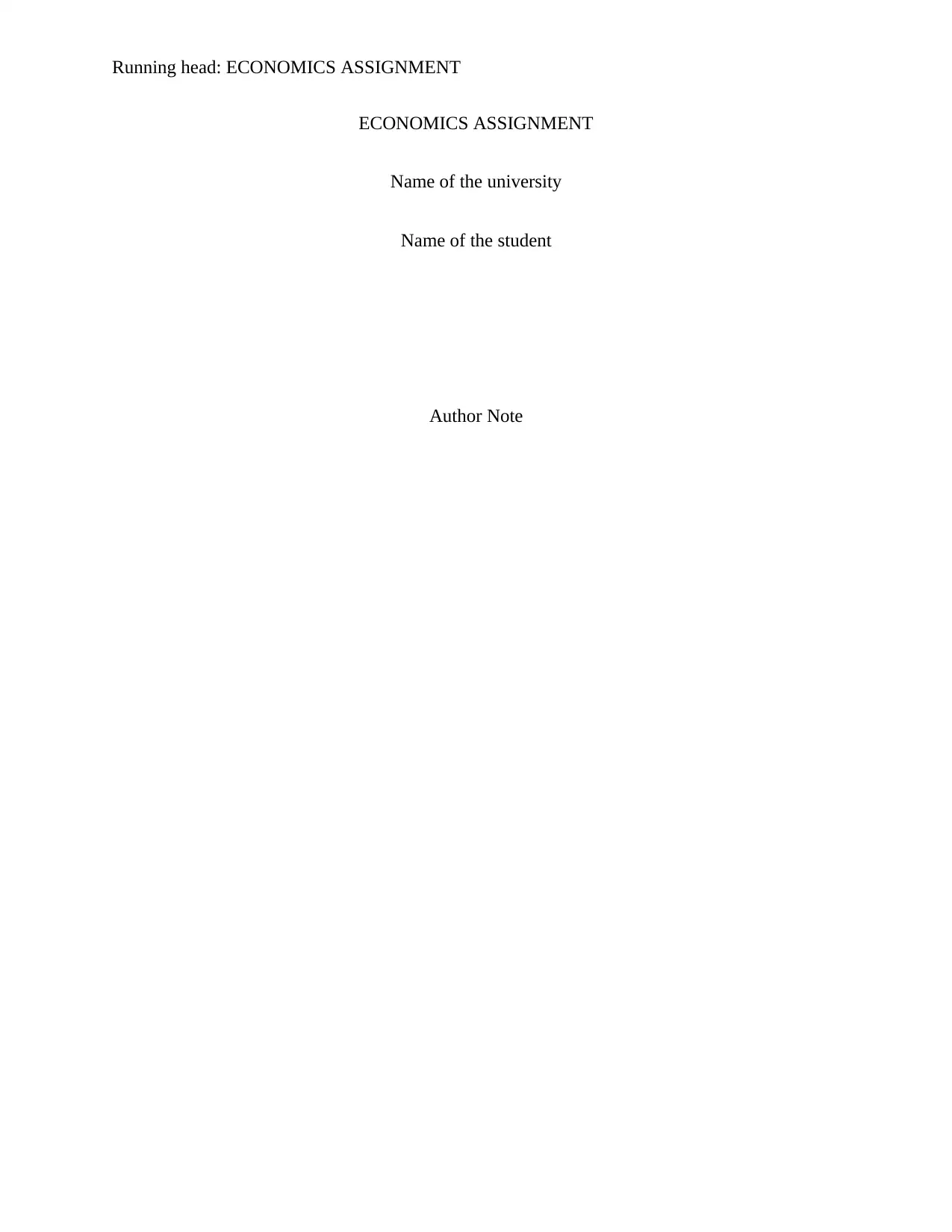
Running head: ECONOMICS ASSIGNMENT
ECONOMICS ASSIGNMENT
Name of the university
Name of the student
Author Note
ECONOMICS ASSIGNMENT
Name of the university
Name of the student
Author Note
Secure Best Marks with AI Grader
Need help grading? Try our AI Grader for instant feedback on your assignments.
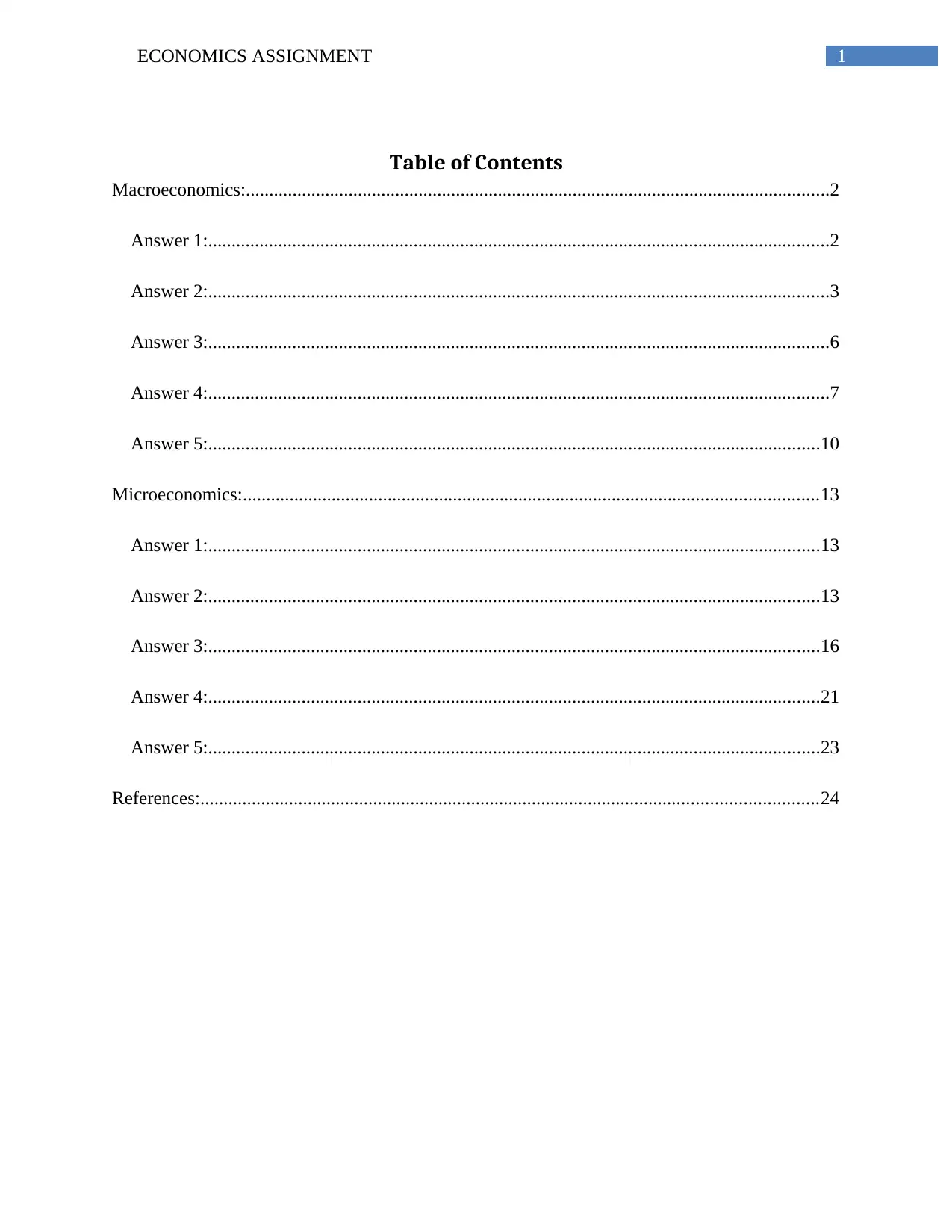
1ECONOMICS ASSIGNMENT
Table of Contents
Macroeconomics:.............................................................................................................................2
Answer 1:.....................................................................................................................................2
Answer 2:.....................................................................................................................................3
Answer 3:.....................................................................................................................................6
Answer 4:.....................................................................................................................................7
Answer 5:...................................................................................................................................10
Microeconomics:...........................................................................................................................13
Answer 1:...................................................................................................................................13
Answer 2:...................................................................................................................................13
Answer 3:...................................................................................................................................16
Answer 4:...................................................................................................................................21
Answer 5:...................................................................................................................................23
References:....................................................................................................................................24
Table of Contents
Macroeconomics:.............................................................................................................................2
Answer 1:.....................................................................................................................................2
Answer 2:.....................................................................................................................................3
Answer 3:.....................................................................................................................................6
Answer 4:.....................................................................................................................................7
Answer 5:...................................................................................................................................10
Microeconomics:...........................................................................................................................13
Answer 1:...................................................................................................................................13
Answer 2:...................................................................................................................................13
Answer 3:...................................................................................................................................16
Answer 4:...................................................................................................................................21
Answer 5:...................................................................................................................................23
References:....................................................................................................................................24

2ECONOMICS ASSIGNMENT
Macroeconomics:
Answer 1:
Calculation of nominal GDP of the years 2013 and 2017:
Nominal GDP2013= (100*10) + (350*4) + (250*20)
Nominal GDP2013= 1000 + 1400 + 5000
Nominal GDP2013= 7400
Therefore, Nominal GDP of the year 2013 is $ 7400
Nominal GDP2017= (150*16) + (230*7) + (150*25)
Nominal GDP2013= 2400 + 1610 + 3750
Nominal GDP2013= 7760
The Nominal GDP of 2017 is $ 7760
Calculation of real GDP of the years 2013 and 2017, assuming 2013 as base year:
Real GDP2013= (100*10) + (350*4) + (250*20)
Real GDP2013= 1000 + 1400 + 5000
Real GDP2013= 7400
The Real GDP in 2013 is $ 7400. The value of Real GDP and nominal GDP is equal.
Real GDP2017= (150*10) + (230*4) + (150*20)
Real GDP2017= 1500 + 920 + 3000
Macroeconomics:
Answer 1:
Calculation of nominal GDP of the years 2013 and 2017:
Nominal GDP2013= (100*10) + (350*4) + (250*20)
Nominal GDP2013= 1000 + 1400 + 5000
Nominal GDP2013= 7400
Therefore, Nominal GDP of the year 2013 is $ 7400
Nominal GDP2017= (150*16) + (230*7) + (150*25)
Nominal GDP2013= 2400 + 1610 + 3750
Nominal GDP2013= 7760
The Nominal GDP of 2017 is $ 7760
Calculation of real GDP of the years 2013 and 2017, assuming 2013 as base year:
Real GDP2013= (100*10) + (350*4) + (250*20)
Real GDP2013= 1000 + 1400 + 5000
Real GDP2013= 7400
The Real GDP in 2013 is $ 7400. The value of Real GDP and nominal GDP is equal.
Real GDP2017= (150*10) + (230*4) + (150*20)
Real GDP2017= 1500 + 920 + 3000
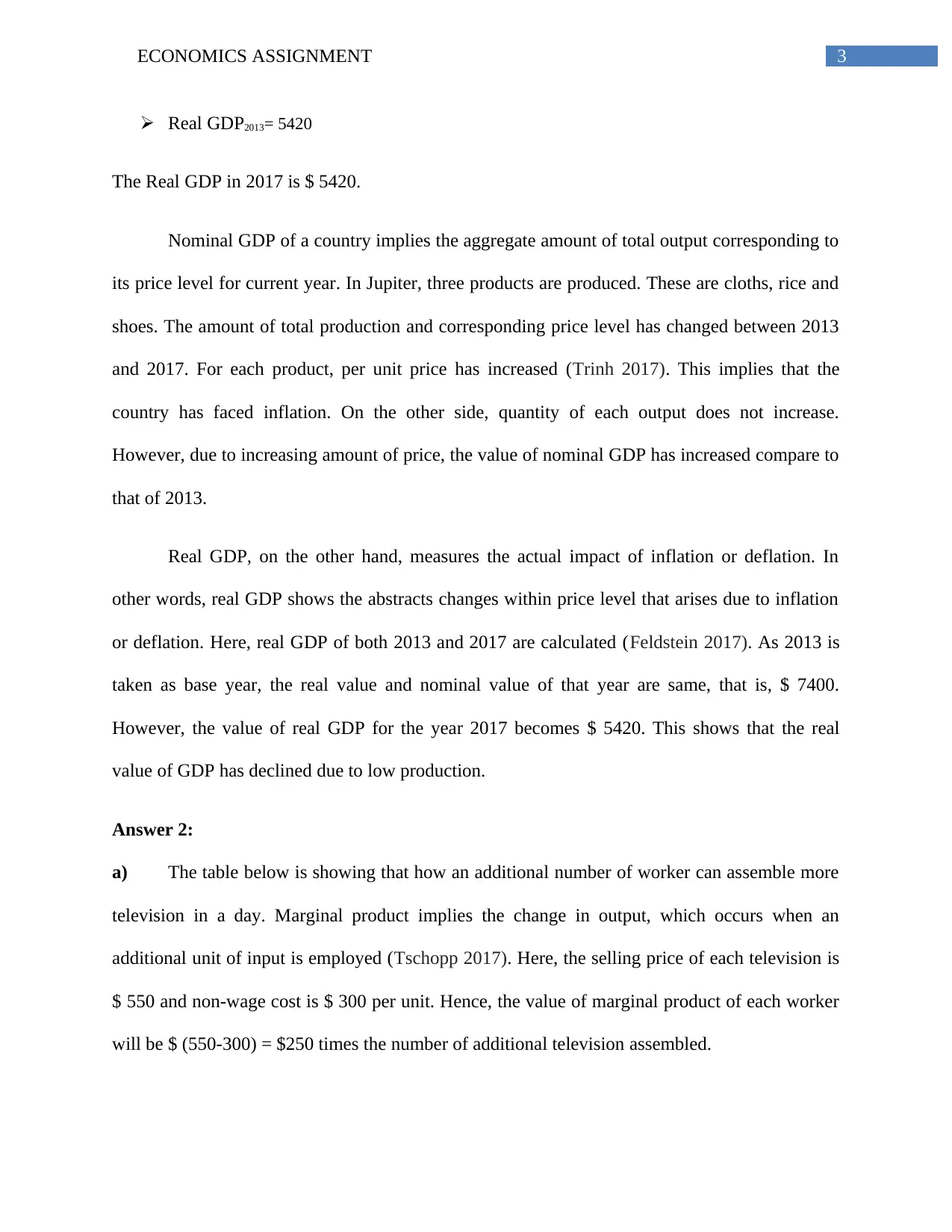
3ECONOMICS ASSIGNMENT
Real GDP2013= 5420
The Real GDP in 2017 is $ 5420.
Nominal GDP of a country implies the aggregate amount of total output corresponding to
its price level for current year. In Jupiter, three products are produced. These are cloths, rice and
shoes. The amount of total production and corresponding price level has changed between 2013
and 2017. For each product, per unit price has increased (Trinh 2017). This implies that the
country has faced inflation. On the other side, quantity of each output does not increase.
However, due to increasing amount of price, the value of nominal GDP has increased compare to
that of 2013.
Real GDP, on the other hand, measures the actual impact of inflation or deflation. In
other words, real GDP shows the abstracts changes within price level that arises due to inflation
or deflation. Here, real GDP of both 2013 and 2017 are calculated (Feldstein 2017). As 2013 is
taken as base year, the real value and nominal value of that year are same, that is, $ 7400.
However, the value of real GDP for the year 2017 becomes $ 5420. This shows that the real
value of GDP has declined due to low production.
Answer 2:
a) The table below is showing that how an additional number of worker can assemble more
television in a day. Marginal product implies the change in output, which occurs when an
additional unit of input is employed (Tschopp 2017). Here, the selling price of each television is
$ 550 and non-wage cost is $ 300 per unit. Hence, the value of marginal product of each worker
will be $ (550-300) = $250 times the number of additional television assembled.
Real GDP2013= 5420
The Real GDP in 2017 is $ 5420.
Nominal GDP of a country implies the aggregate amount of total output corresponding to
its price level for current year. In Jupiter, three products are produced. These are cloths, rice and
shoes. The amount of total production and corresponding price level has changed between 2013
and 2017. For each product, per unit price has increased (Trinh 2017). This implies that the
country has faced inflation. On the other side, quantity of each output does not increase.
However, due to increasing amount of price, the value of nominal GDP has increased compare to
that of 2013.
Real GDP, on the other hand, measures the actual impact of inflation or deflation. In
other words, real GDP shows the abstracts changes within price level that arises due to inflation
or deflation. Here, real GDP of both 2013 and 2017 are calculated (Feldstein 2017). As 2013 is
taken as base year, the real value and nominal value of that year are same, that is, $ 7400.
However, the value of real GDP for the year 2017 becomes $ 5420. This shows that the real
value of GDP has declined due to low production.
Answer 2:
a) The table below is showing that how an additional number of worker can assemble more
television in a day. Marginal product implies the change in output, which occurs when an
additional unit of input is employed (Tschopp 2017). Here, the selling price of each television is
$ 550 and non-wage cost is $ 300 per unit. Hence, the value of marginal product of each worker
will be $ (550-300) = $250 times the number of additional television assembled.
Secure Best Marks with AI Grader
Need help grading? Try our AI Grader for instant feedback on your assignments.
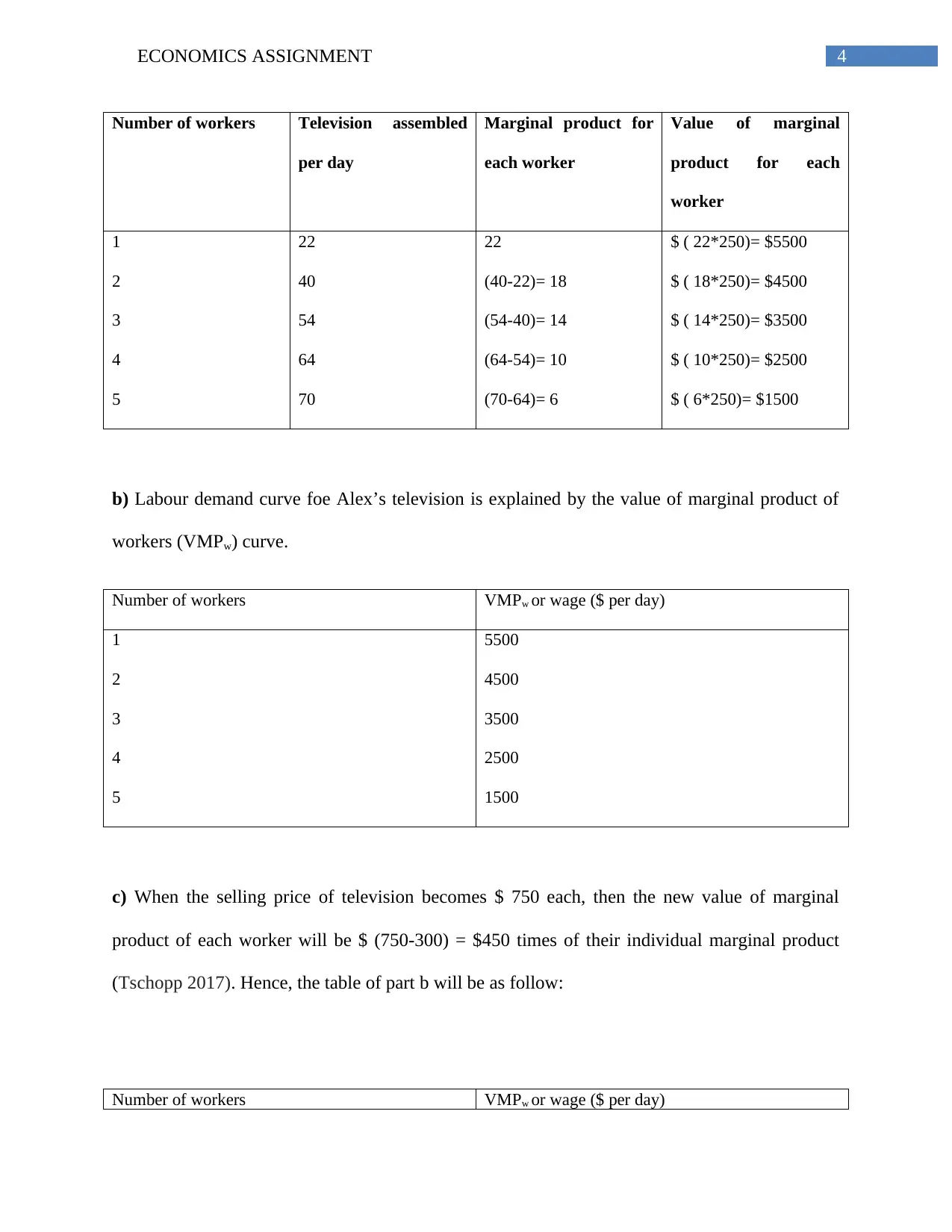
4ECONOMICS ASSIGNMENT
Number of workers Television assembled
per day
Marginal product for
each worker
Value of marginal
product for each
worker
1
2
3
4
5
22
40
54
64
70
22
(40-22)= 18
(54-40)= 14
(64-54)= 10
(70-64)= 6
$ ( 22*250)= $5500
$ ( 18*250)= $4500
$ ( 14*250)= $3500
$ ( 10*250)= $2500
$ ( 6*250)= $1500
b) Labour demand curve foe Alex’s television is explained by the value of marginal product of
workers (VMPw) curve.
Number of workers VMPw or wage ($ per day)
1
2
3
4
5
5500
4500
3500
2500
1500
c) When the selling price of television becomes $ 750 each, then the new value of marginal
product of each worker will be $ (750-300) = $450 times of their individual marginal product
(Tschopp 2017). Hence, the table of part b will be as follow:
Number of workers VMPw or wage ($ per day)
Number of workers Television assembled
per day
Marginal product for
each worker
Value of marginal
product for each
worker
1
2
3
4
5
22
40
54
64
70
22
(40-22)= 18
(54-40)= 14
(64-54)= 10
(70-64)= 6
$ ( 22*250)= $5500
$ ( 18*250)= $4500
$ ( 14*250)= $3500
$ ( 10*250)= $2500
$ ( 6*250)= $1500
b) Labour demand curve foe Alex’s television is explained by the value of marginal product of
workers (VMPw) curve.
Number of workers VMPw or wage ($ per day)
1
2
3
4
5
5500
4500
3500
2500
1500
c) When the selling price of television becomes $ 750 each, then the new value of marginal
product of each worker will be $ (750-300) = $450 times of their individual marginal product
(Tschopp 2017). Hence, the table of part b will be as follow:
Number of workers VMPw or wage ($ per day)
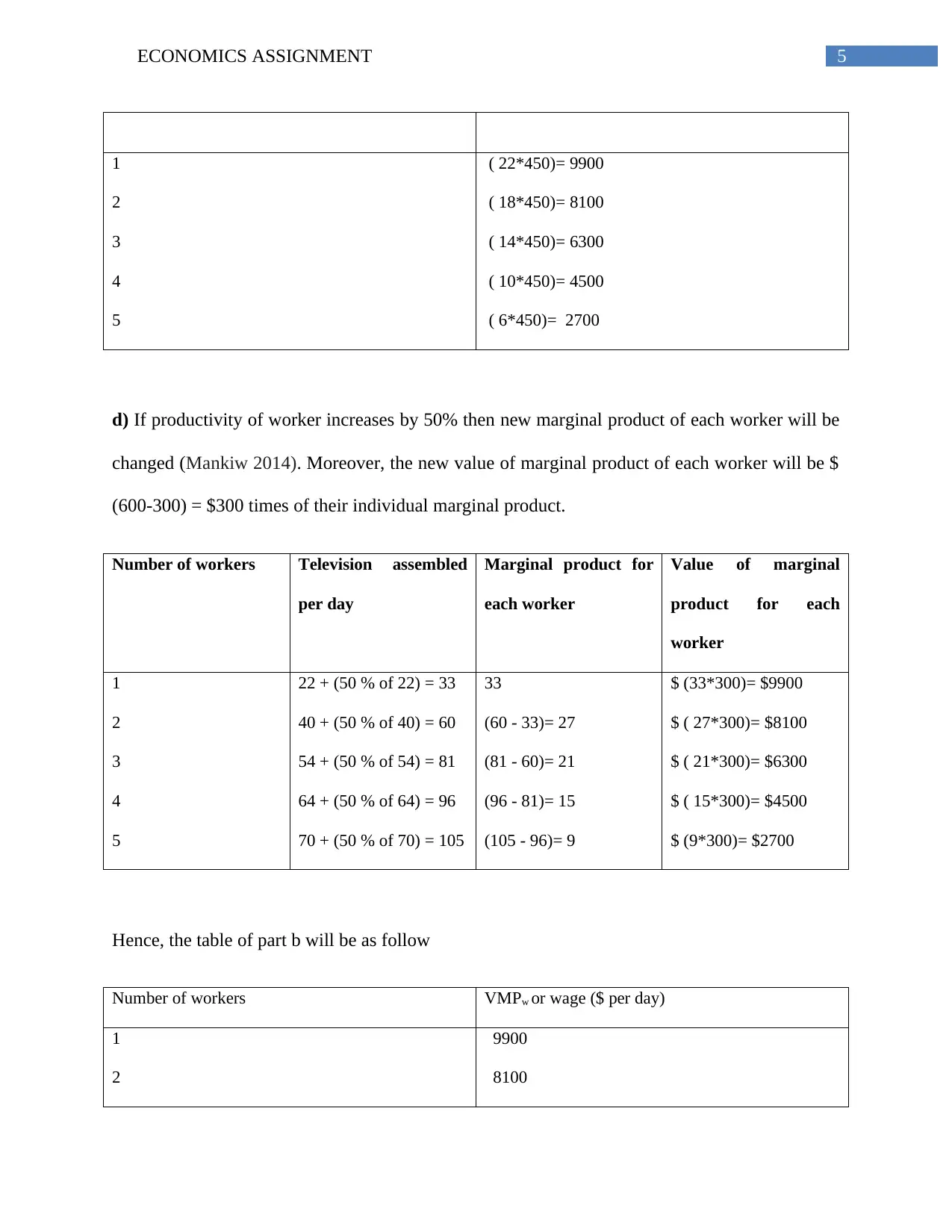
5ECONOMICS ASSIGNMENT
1
2
3
4
5
( 22*450)= 9900
( 18*450)= 8100
( 14*450)= 6300
( 10*450)= 4500
( 6*450)= 2700
d) If productivity of worker increases by 50% then new marginal product of each worker will be
changed (Mankiw 2014). Moreover, the new value of marginal product of each worker will be $
(600-300) = $300 times of their individual marginal product.
Number of workers Television assembled
per day
Marginal product for
each worker
Value of marginal
product for each
worker
1
2
3
4
5
22 + (50 % of 22) = 33
40 + (50 % of 40) = 60
54 + (50 % of 54) = 81
64 + (50 % of 64) = 96
70 + (50 % of 70) = 105
33
(60 - 33)= 27
(81 - 60)= 21
(96 - 81)= 15
(105 - 96)= 9
$ (33*300)= $9900
$ ( 27*300)= $8100
$ ( 21*300)= $6300
$ ( 15*300)= $4500
$ (9*300)= $2700
Hence, the table of part b will be as follow
Number of workers VMPw or wage ($ per day)
1
2
9900
8100
1
2
3
4
5
( 22*450)= 9900
( 18*450)= 8100
( 14*450)= 6300
( 10*450)= 4500
( 6*450)= 2700
d) If productivity of worker increases by 50% then new marginal product of each worker will be
changed (Mankiw 2014). Moreover, the new value of marginal product of each worker will be $
(600-300) = $300 times of their individual marginal product.
Number of workers Television assembled
per day
Marginal product for
each worker
Value of marginal
product for each
worker
1
2
3
4
5
22 + (50 % of 22) = 33
40 + (50 % of 40) = 60
54 + (50 % of 54) = 81
64 + (50 % of 64) = 96
70 + (50 % of 70) = 105
33
(60 - 33)= 27
(81 - 60)= 21
(96 - 81)= 15
(105 - 96)= 9
$ (33*300)= $9900
$ ( 27*300)= $8100
$ ( 21*300)= $6300
$ ( 15*300)= $4500
$ (9*300)= $2700
Hence, the table of part b will be as follow
Number of workers VMPw or wage ($ per day)
1
2
9900
8100
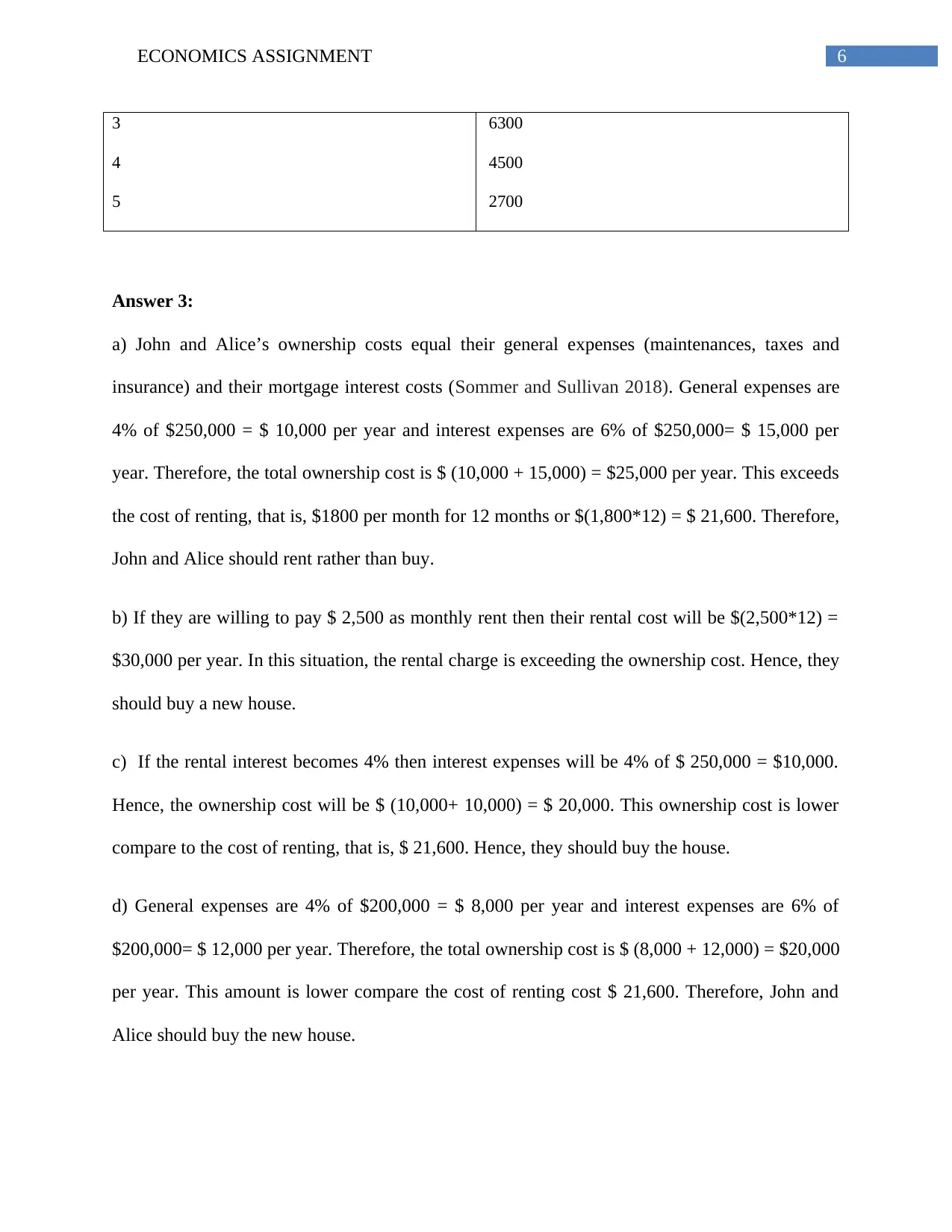
6ECONOMICS ASSIGNMENT
3
4
5
6300
4500
2700
Answer 3:
a) John and Alice’s ownership costs equal their general expenses (maintenances, taxes and
insurance) and their mortgage interest costs (Sommer and Sullivan 2018). General expenses are
4% of $250,000 = $ 10,000 per year and interest expenses are 6% of $250,000= $ 15,000 per
year. Therefore, the total ownership cost is $ (10,000 + 15,000) = $25,000 per year. This exceeds
the cost of renting, that is, $1800 per month for 12 months or $(1,800*12) = $ 21,600. Therefore,
John and Alice should rent rather than buy.
b) If they are willing to pay $ 2,500 as monthly rent then their rental cost will be $(2,500*12) =
$30,000 per year. In this situation, the rental charge is exceeding the ownership cost. Hence, they
should buy a new house.
c) If the rental interest becomes 4% then interest expenses will be 4% of $ 250,000 = $10,000.
Hence, the ownership cost will be $ (10,000+ 10,000) = $ 20,000. This ownership cost is lower
compare to the cost of renting, that is, $ 21,600. Hence, they should buy the house.
d) General expenses are 4% of $200,000 = $ 8,000 per year and interest expenses are 6% of
$200,000= $ 12,000 per year. Therefore, the total ownership cost is $ (8,000 + 12,000) = $20,000
per year. This amount is lower compare the cost of renting cost $ 21,600. Therefore, John and
Alice should buy the new house.
3
4
5
6300
4500
2700
Answer 3:
a) John and Alice’s ownership costs equal their general expenses (maintenances, taxes and
insurance) and their mortgage interest costs (Sommer and Sullivan 2018). General expenses are
4% of $250,000 = $ 10,000 per year and interest expenses are 6% of $250,000= $ 15,000 per
year. Therefore, the total ownership cost is $ (10,000 + 15,000) = $25,000 per year. This exceeds
the cost of renting, that is, $1800 per month for 12 months or $(1,800*12) = $ 21,600. Therefore,
John and Alice should rent rather than buy.
b) If they are willing to pay $ 2,500 as monthly rent then their rental cost will be $(2,500*12) =
$30,000 per year. In this situation, the rental charge is exceeding the ownership cost. Hence, they
should buy a new house.
c) If the rental interest becomes 4% then interest expenses will be 4% of $ 250,000 = $10,000.
Hence, the ownership cost will be $ (10,000+ 10,000) = $ 20,000. This ownership cost is lower
compare to the cost of renting, that is, $ 21,600. Hence, they should buy the house.
d) General expenses are 4% of $200,000 = $ 8,000 per year and interest expenses are 6% of
$200,000= $ 12,000 per year. Therefore, the total ownership cost is $ (8,000 + 12,000) = $20,000
per year. This amount is lower compare the cost of renting cost $ 21,600. Therefore, John and
Alice should buy the new house.
Paraphrase This Document
Need a fresh take? Get an instant paraphrase of this document with our AI Paraphraser
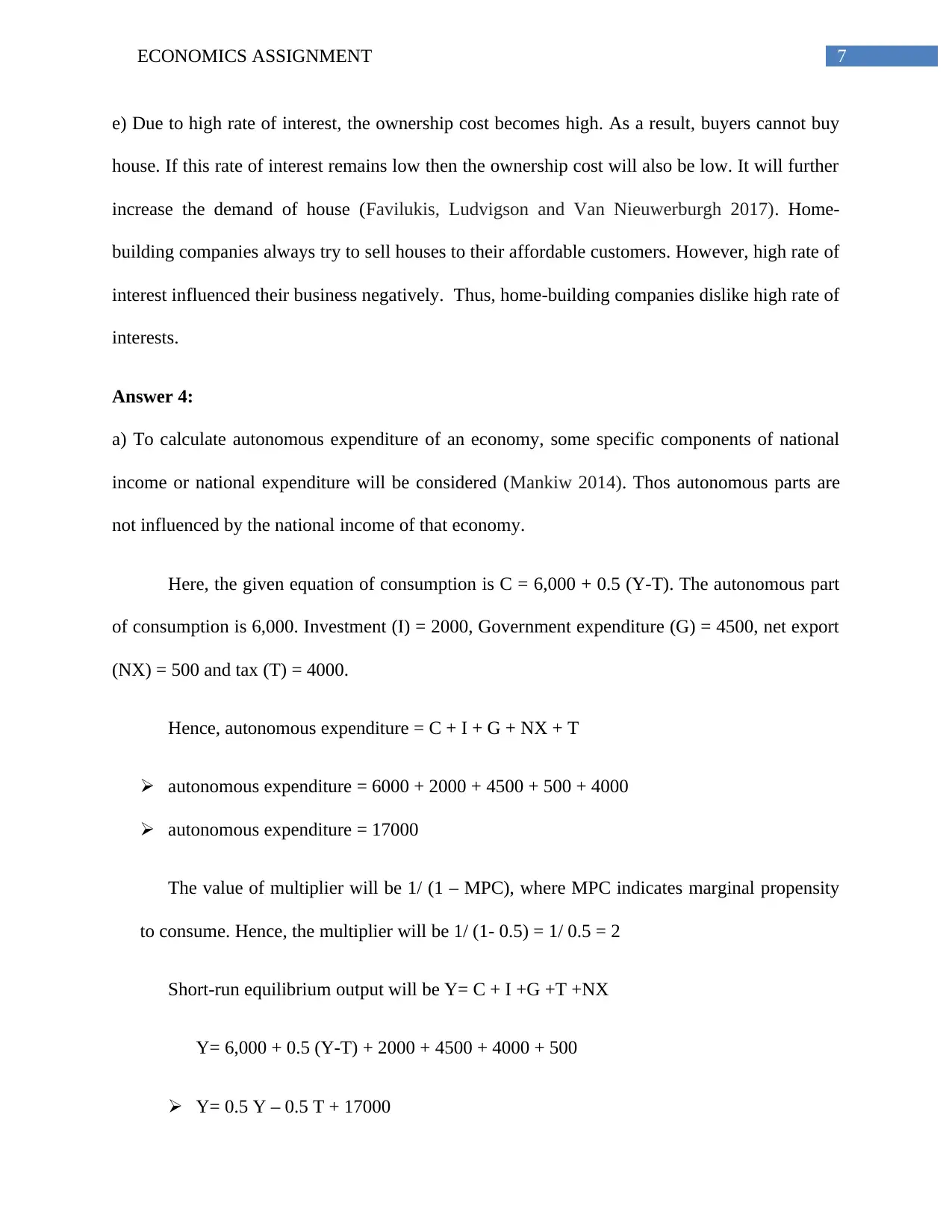
7ECONOMICS ASSIGNMENT
e) Due to high rate of interest, the ownership cost becomes high. As a result, buyers cannot buy
house. If this rate of interest remains low then the ownership cost will also be low. It will further
increase the demand of house (Favilukis, Ludvigson and Van Nieuwerburgh 2017). Home-
building companies always try to sell houses to their affordable customers. However, high rate of
interest influenced their business negatively. Thus, home-building companies dislike high rate of
interests.
Answer 4:
a) To calculate autonomous expenditure of an economy, some specific components of national
income or national expenditure will be considered (Mankiw 2014). Thos autonomous parts are
not influenced by the national income of that economy.
Here, the given equation of consumption is C = 6,000 + 0.5 (Y-T). The autonomous part
of consumption is 6,000. Investment (I) = 2000, Government expenditure (G) = 4500, net export
(NX) = 500 and tax (T) = 4000.
Hence, autonomous expenditure = C + I + G + NX + T
autonomous expenditure = 6000 + 2000 + 4500 + 500 + 4000
autonomous expenditure = 17000
The value of multiplier will be 1/ (1 – MPC), where MPC indicates marginal propensity
to consume. Hence, the multiplier will be 1/ (1- 0.5) = 1/ 0.5 = 2
Short-run equilibrium output will be Y= C + I +G +T +NX
Y= 6,000 + 0.5 (Y-T) + 2000 + 4500 + 4000 + 500
Y= 0.5 Y – 0.5 T + 17000
e) Due to high rate of interest, the ownership cost becomes high. As a result, buyers cannot buy
house. If this rate of interest remains low then the ownership cost will also be low. It will further
increase the demand of house (Favilukis, Ludvigson and Van Nieuwerburgh 2017). Home-
building companies always try to sell houses to their affordable customers. However, high rate of
interest influenced their business negatively. Thus, home-building companies dislike high rate of
interests.
Answer 4:
a) To calculate autonomous expenditure of an economy, some specific components of national
income or national expenditure will be considered (Mankiw 2014). Thos autonomous parts are
not influenced by the national income of that economy.
Here, the given equation of consumption is C = 6,000 + 0.5 (Y-T). The autonomous part
of consumption is 6,000. Investment (I) = 2000, Government expenditure (G) = 4500, net export
(NX) = 500 and tax (T) = 4000.
Hence, autonomous expenditure = C + I + G + NX + T
autonomous expenditure = 6000 + 2000 + 4500 + 500 + 4000
autonomous expenditure = 17000
The value of multiplier will be 1/ (1 – MPC), where MPC indicates marginal propensity
to consume. Hence, the multiplier will be 1/ (1- 0.5) = 1/ 0.5 = 2
Short-run equilibrium output will be Y= C + I +G +T +NX
Y= 6,000 + 0.5 (Y-T) + 2000 + 4500 + 4000 + 500
Y= 0.5 Y – 0.5 T + 17000
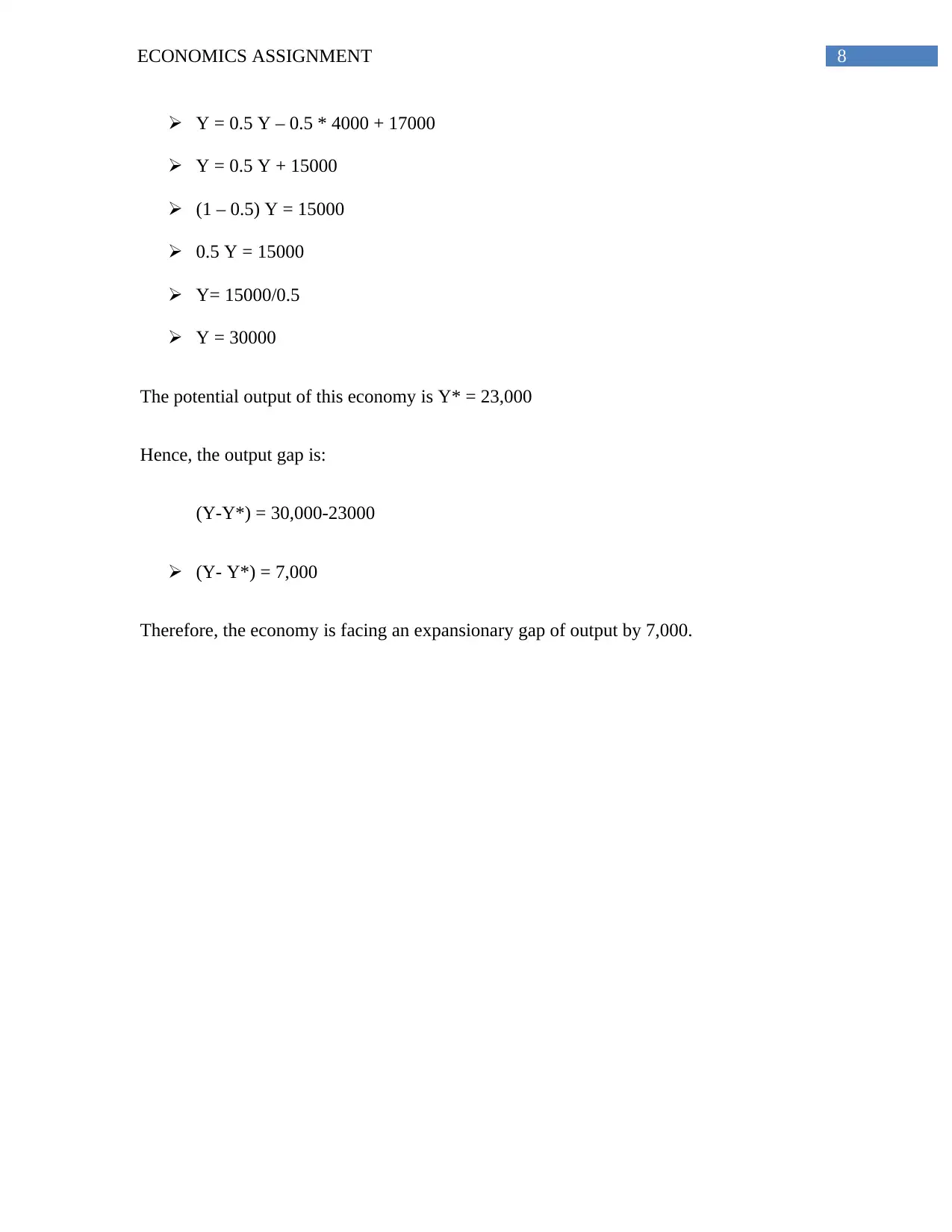
8ECONOMICS ASSIGNMENT
Y = 0.5 Y – 0.5 * 4000 + 17000
Y = 0.5 Y + 15000
(1 – 0.5) Y = 15000
0.5 Y = 15000
Y= 15000/0.5
Y = 30000
The potential output of this economy is Y* = 23,000
Hence, the output gap is:
(Y-Y*) = 30,000-23000
(Y- Y*) = 7,000
Therefore, the economy is facing an expansionary gap of output by 7,000.
Y = 0.5 Y – 0.5 * 4000 + 17000
Y = 0.5 Y + 15000
(1 – 0.5) Y = 15000
0.5 Y = 15000
Y= 15000/0.5
Y = 30000
The potential output of this economy is Y* = 23,000
Hence, the output gap is:
(Y-Y*) = 30,000-23000
(Y- Y*) = 7,000
Therefore, the economy is facing an expansionary gap of output by 7,000.
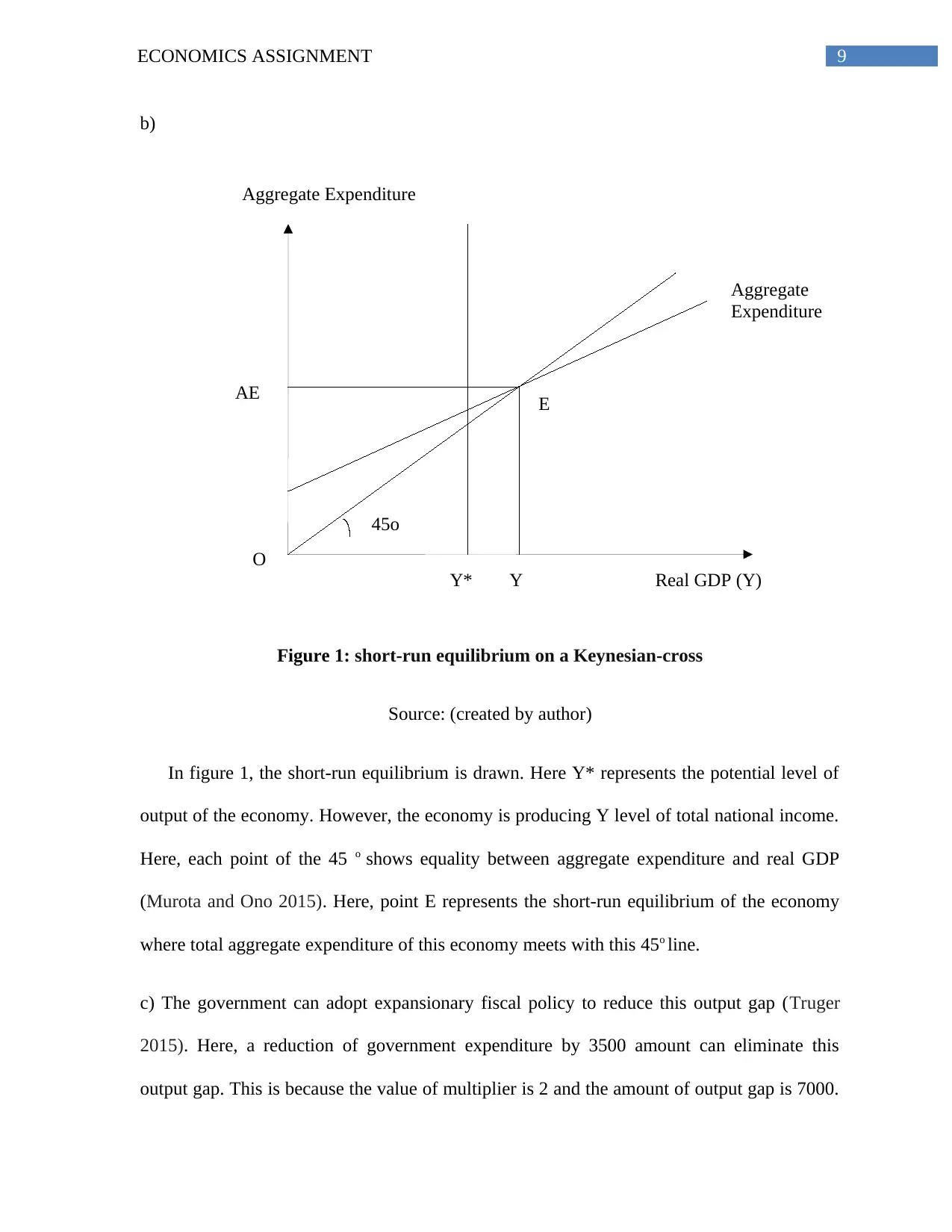
9ECONOMICS ASSIGNMENT
Y* Y
45o
Real GDP (Y)
Aggregate
Expenditure
Aggregate Expenditure
O
E
AE
b)
Figure 1: short-run equilibrium on a Keynesian-cross
Source: (created by author)
In figure 1, the short-run equilibrium is drawn. Here Y* represents the potential level of
output of the economy. However, the economy is producing Y level of total national income.
Here, each point of the 45 o shows equality between aggregate expenditure and real GDP
(Murota and Ono 2015). Here, point E represents the short-run equilibrium of the economy
where total aggregate expenditure of this economy meets with this 45o line.
c) The government can adopt expansionary fiscal policy to reduce this output gap (Truger
2015). Here, a reduction of government expenditure by 3500 amount can eliminate this
output gap. This is because the value of multiplier is 2 and the amount of output gap is 7000.
Y* Y
45o
Real GDP (Y)
Aggregate
Expenditure
Aggregate Expenditure
O
E
AE
b)
Figure 1: short-run equilibrium on a Keynesian-cross
Source: (created by author)
In figure 1, the short-run equilibrium is drawn. Here Y* represents the potential level of
output of the economy. However, the economy is producing Y level of total national income.
Here, each point of the 45 o shows equality between aggregate expenditure and real GDP
(Murota and Ono 2015). Here, point E represents the short-run equilibrium of the economy
where total aggregate expenditure of this economy meets with this 45o line.
c) The government can adopt expansionary fiscal policy to reduce this output gap (Truger
2015). Here, a reduction of government expenditure by 3500 amount can eliminate this
output gap. This is because the value of multiplier is 2 and the amount of output gap is 7000.
Secure Best Marks with AI Grader
Need help grading? Try our AI Grader for instant feedback on your assignments.
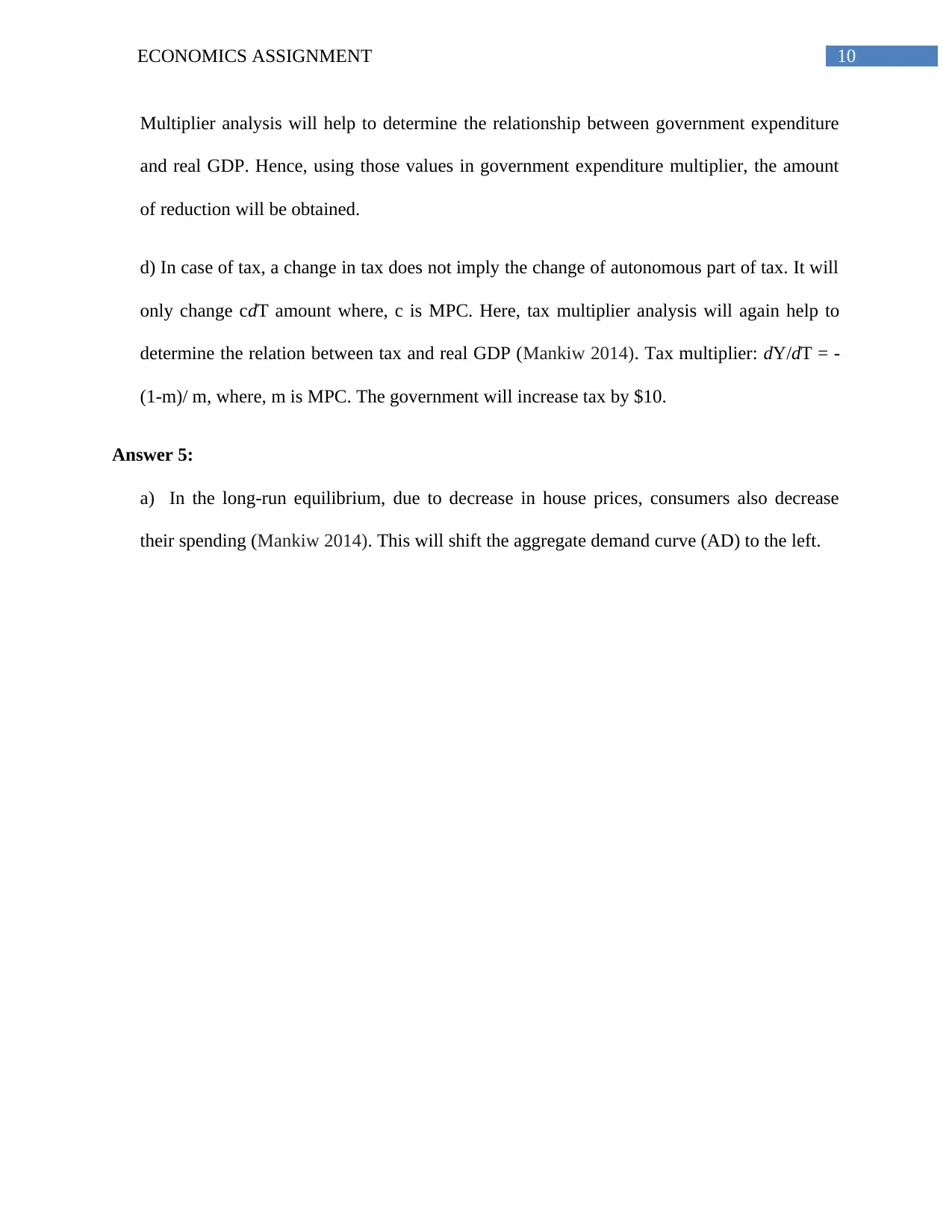
10ECONOMICS ASSIGNMENT
Multiplier analysis will help to determine the relationship between government expenditure
and real GDP. Hence, using those values in government expenditure multiplier, the amount
of reduction will be obtained.
d) In case of tax, a change in tax does not imply the change of autonomous part of tax. It will
only change cdT amount where, c is MPC. Here, tax multiplier analysis will again help to
determine the relation between tax and real GDP (Mankiw 2014). Tax multiplier: dY/dT = -
(1-m)/ m, where, m is MPC. The government will increase tax by $10.
Answer 5:
a) In the long-run equilibrium, due to decrease in house prices, consumers also decrease
their spending (Mankiw 2014). This will shift the aggregate demand curve (AD) to the left.
Multiplier analysis will help to determine the relationship between government expenditure
and real GDP. Hence, using those values in government expenditure multiplier, the amount
of reduction will be obtained.
d) In case of tax, a change in tax does not imply the change of autonomous part of tax. It will
only change cdT amount where, c is MPC. Here, tax multiplier analysis will again help to
determine the relation between tax and real GDP (Mankiw 2014). Tax multiplier: dY/dT = -
(1-m)/ m, where, m is MPC. The government will increase tax by $10.
Answer 5:
a) In the long-run equilibrium, due to decrease in house prices, consumers also decrease
their spending (Mankiw 2014). This will shift the aggregate demand curve (AD) to the left.
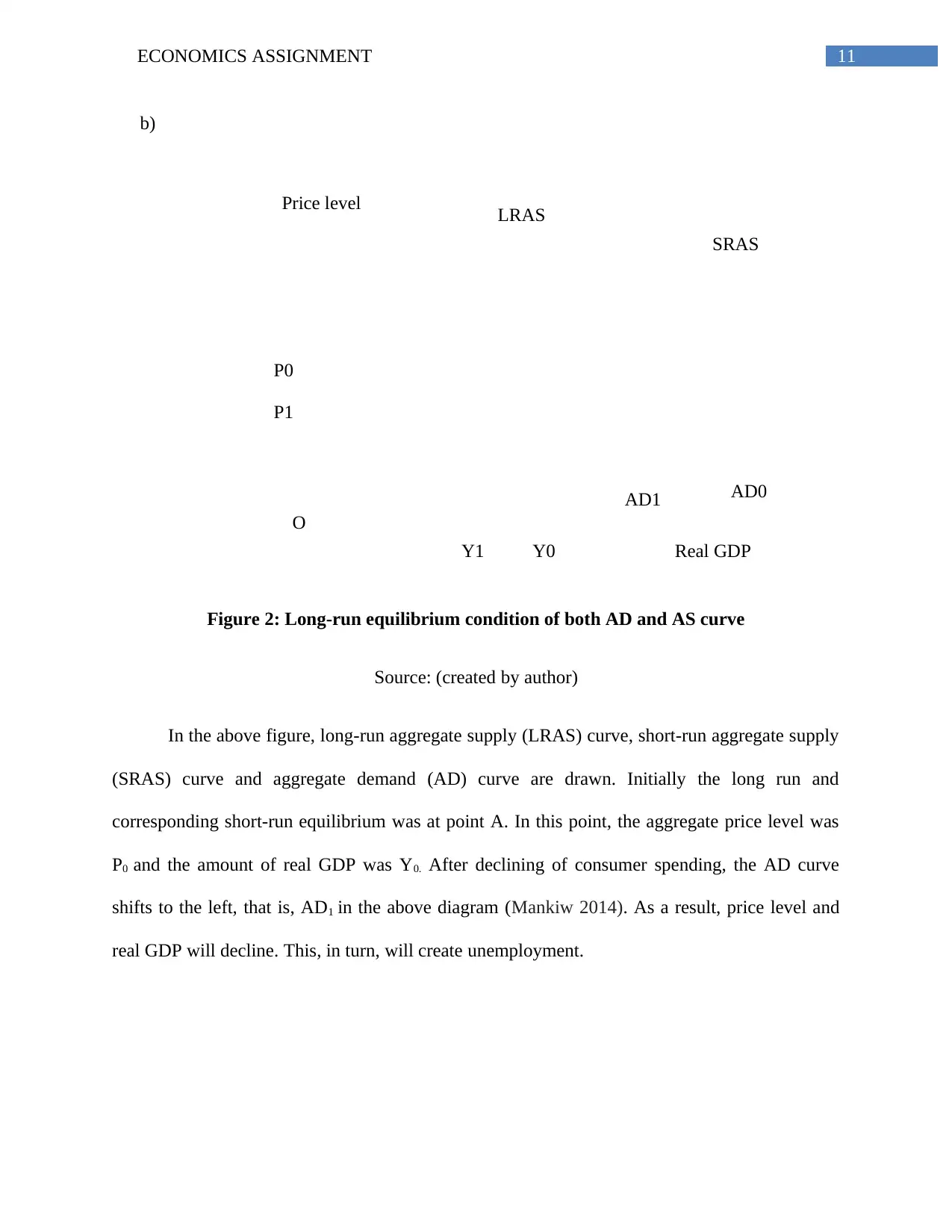
11ECONOMICS ASSIGNMENT
Price level
Real GDP
O
LRAS
SRAS
AD0AD1
P0
P1
Y0Y1
b)
Figure 2: Long-run equilibrium condition of both AD and AS curve
Source: (created by author)
In the above figure, long-run aggregate supply (LRAS) curve, short-run aggregate supply
(SRAS) curve and aggregate demand (AD) curve are drawn. Initially the long run and
corresponding short-run equilibrium was at point A. In this point, the aggregate price level was
P0 and the amount of real GDP was Y0. After declining of consumer spending, the AD curve
shifts to the left, that is, AD1 in the above diagram (Mankiw 2014). As a result, price level and
real GDP will decline. This, in turn, will create unemployment.
Price level
Real GDP
O
LRAS
SRAS
AD0AD1
P0
P1
Y0Y1
b)
Figure 2: Long-run equilibrium condition of both AD and AS curve
Source: (created by author)
In the above figure, long-run aggregate supply (LRAS) curve, short-run aggregate supply
(SRAS) curve and aggregate demand (AD) curve are drawn. Initially the long run and
corresponding short-run equilibrium was at point A. In this point, the aggregate price level was
P0 and the amount of real GDP was Y0. After declining of consumer spending, the AD curve
shifts to the left, that is, AD1 in the above diagram (Mankiw 2014). As a result, price level and
real GDP will decline. This, in turn, will create unemployment.
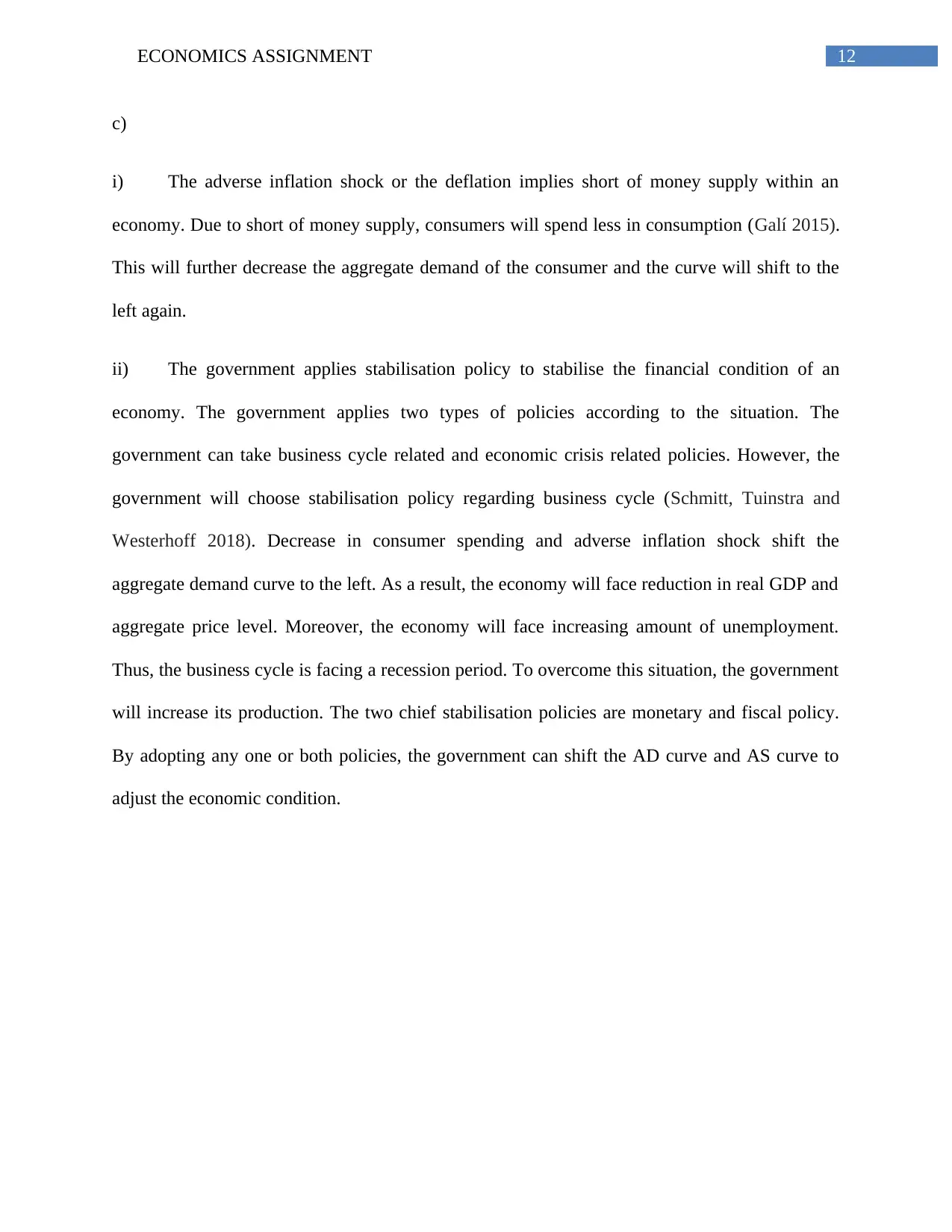
12ECONOMICS ASSIGNMENT
c)
i) The adverse inflation shock or the deflation implies short of money supply within an
economy. Due to short of money supply, consumers will spend less in consumption (Galí 2015).
This will further decrease the aggregate demand of the consumer and the curve will shift to the
left again.
ii) The government applies stabilisation policy to stabilise the financial condition of an
economy. The government applies two types of policies according to the situation. The
government can take business cycle related and economic crisis related policies. However, the
government will choose stabilisation policy regarding business cycle (Schmitt, Tuinstra and
Westerhoff 2018). Decrease in consumer spending and adverse inflation shock shift the
aggregate demand curve to the left. As a result, the economy will face reduction in real GDP and
aggregate price level. Moreover, the economy will face increasing amount of unemployment.
Thus, the business cycle is facing a recession period. To overcome this situation, the government
will increase its production. The two chief stabilisation policies are monetary and fiscal policy.
By adopting any one or both policies, the government can shift the AD curve and AS curve to
adjust the economic condition.
c)
i) The adverse inflation shock or the deflation implies short of money supply within an
economy. Due to short of money supply, consumers will spend less in consumption (Galí 2015).
This will further decrease the aggregate demand of the consumer and the curve will shift to the
left again.
ii) The government applies stabilisation policy to stabilise the financial condition of an
economy. The government applies two types of policies according to the situation. The
government can take business cycle related and economic crisis related policies. However, the
government will choose stabilisation policy regarding business cycle (Schmitt, Tuinstra and
Westerhoff 2018). Decrease in consumer spending and adverse inflation shock shift the
aggregate demand curve to the left. As a result, the economy will face reduction in real GDP and
aggregate price level. Moreover, the economy will face increasing amount of unemployment.
Thus, the business cycle is facing a recession period. To overcome this situation, the government
will increase its production. The two chief stabilisation policies are monetary and fiscal policy.
By adopting any one or both policies, the government can shift the AD curve and AS curve to
adjust the economic condition.
Paraphrase This Document
Need a fresh take? Get an instant paraphrase of this document with our AI Paraphraser
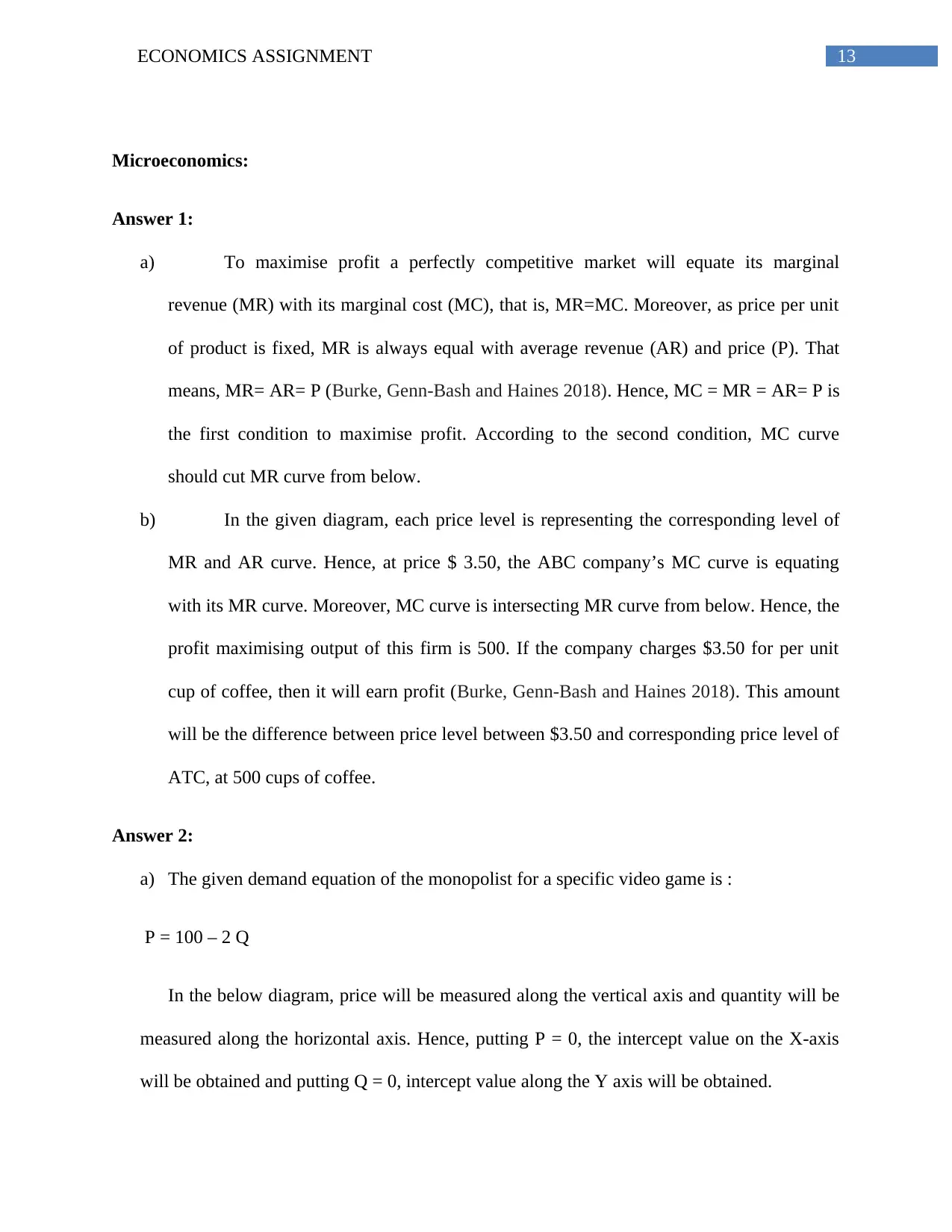
13ECONOMICS ASSIGNMENT
Microeconomics:
Answer 1:
a) To maximise profit a perfectly competitive market will equate its marginal
revenue (MR) with its marginal cost (MC), that is, MR=MC. Moreover, as price per unit
of product is fixed, MR is always equal with average revenue (AR) and price (P). That
means, MR= AR= P (Burke, Genn-Bash and Haines 2018). Hence, MC = MR = AR= P is
the first condition to maximise profit. According to the second condition, MC curve
should cut MR curve from below.
b) In the given diagram, each price level is representing the corresponding level of
MR and AR curve. Hence, at price $ 3.50, the ABC company’s MC curve is equating
with its MR curve. Moreover, MC curve is intersecting MR curve from below. Hence, the
profit maximising output of this firm is 500. If the company charges $3.50 for per unit
cup of coffee, then it will earn profit (Burke, Genn-Bash and Haines 2018). This amount
will be the difference between price level between $3.50 and corresponding price level of
ATC, at 500 cups of coffee.
Answer 2:
a) The given demand equation of the monopolist for a specific video game is :
P = 100 – 2 Q
In the below diagram, price will be measured along the vertical axis and quantity will be
measured along the horizontal axis. Hence, putting P = 0, the intercept value on the X-axis
will be obtained and putting Q = 0, intercept value along the Y axis will be obtained.
Microeconomics:
Answer 1:
a) To maximise profit a perfectly competitive market will equate its marginal
revenue (MR) with its marginal cost (MC), that is, MR=MC. Moreover, as price per unit
of product is fixed, MR is always equal with average revenue (AR) and price (P). That
means, MR= AR= P (Burke, Genn-Bash and Haines 2018). Hence, MC = MR = AR= P is
the first condition to maximise profit. According to the second condition, MC curve
should cut MR curve from below.
b) In the given diagram, each price level is representing the corresponding level of
MR and AR curve. Hence, at price $ 3.50, the ABC company’s MC curve is equating
with its MR curve. Moreover, MC curve is intersecting MR curve from below. Hence, the
profit maximising output of this firm is 500. If the company charges $3.50 for per unit
cup of coffee, then it will earn profit (Burke, Genn-Bash and Haines 2018). This amount
will be the difference between price level between $3.50 and corresponding price level of
ATC, at 500 cups of coffee.
Answer 2:
a) The given demand equation of the monopolist for a specific video game is :
P = 100 – 2 Q
In the below diagram, price will be measured along the vertical axis and quantity will be
measured along the horizontal axis. Hence, putting P = 0, the intercept value on the X-axis
will be obtained and putting Q = 0, intercept value along the Y axis will be obtained.
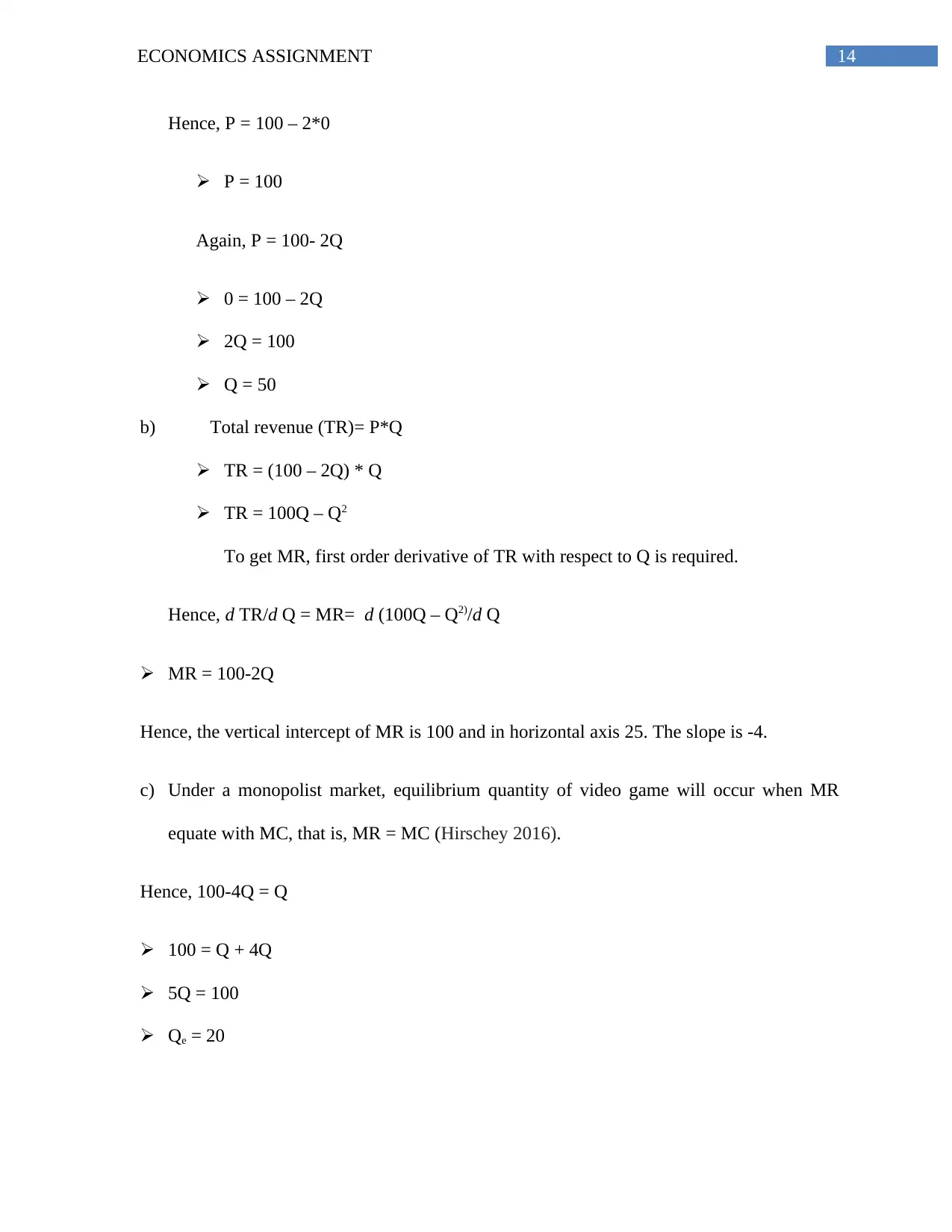
14ECONOMICS ASSIGNMENT
Hence, P = 100 – 2*0
P = 100
Again, P = 100- 2Q
0 = 100 – 2Q
2Q = 100
Q = 50
b) Total revenue (TR)= P*Q
TR = (100 – 2Q) * Q
TR = 100Q – Q2
To get MR, first order derivative of TR with respect to Q is required.
Hence, d TR/d Q = MR= d (100Q – Q2)/d Q
MR = 100-2Q
Hence, the vertical intercept of MR is 100 and in horizontal axis 25. The slope is -4.
c) Under a monopolist market, equilibrium quantity of video game will occur when MR
equate with MC, that is, MR = MC (Hirschey 2016).
Hence, 100-4Q = Q
100 = Q + 4Q
5Q = 100
Qe = 20
Hence, P = 100 – 2*0
P = 100
Again, P = 100- 2Q
0 = 100 – 2Q
2Q = 100
Q = 50
b) Total revenue (TR)= P*Q
TR = (100 – 2Q) * Q
TR = 100Q – Q2
To get MR, first order derivative of TR with respect to Q is required.
Hence, d TR/d Q = MR= d (100Q – Q2)/d Q
MR = 100-2Q
Hence, the vertical intercept of MR is 100 and in horizontal axis 25. The slope is -4.
c) Under a monopolist market, equilibrium quantity of video game will occur when MR
equate with MC, that is, MR = MC (Hirschey 2016).
Hence, 100-4Q = Q
100 = Q + 4Q
5Q = 100
Qe = 20

15ECONOMICS ASSIGNMENT
100
50
O
Price
Quantity of video game
AR = Demand curve
MC = Q
Slope of MC = 1
S
S
Slope of demand curve= -2
25
MR
Slope of MR = -4
20
60
A
B
C
20
Hence, the equilibrium quantity of video game is 20. To get equilibrium price, the value
of Qe is putted into the demand equation.
Hence, P = 100 – 2*20
P = 100-40
Pe = 60
Therefore, the equilibrium quantity of video game is 60.
Figure 3: Monopolistic equilibrium and consumer surplus
d) Profit means the difference of revenue from its marginal cost and fixed cost (Baumol and
Blinder 2015).
Hence, Profit = TR – MC – fixed cost
Profit = ( 60*20) - (20*20) – 500
100
50
O
Price
Quantity of video game
AR = Demand curve
MC = Q
Slope of MC = 1
S
S
Slope of demand curve= -2
25
MR
Slope of MR = -4
20
60
A
B
C
20
Hence, the equilibrium quantity of video game is 20. To get equilibrium price, the value
of Qe is putted into the demand equation.
Hence, P = 100 – 2*20
P = 100-40
Pe = 60
Therefore, the equilibrium quantity of video game is 60.
Figure 3: Monopolistic equilibrium and consumer surplus
d) Profit means the difference of revenue from its marginal cost and fixed cost (Baumol and
Blinder 2015).
Hence, Profit = TR – MC – fixed cost
Profit = ( 60*20) - (20*20) – 500
Secure Best Marks with AI Grader
Need help grading? Try our AI Grader for instant feedback on your assignments.
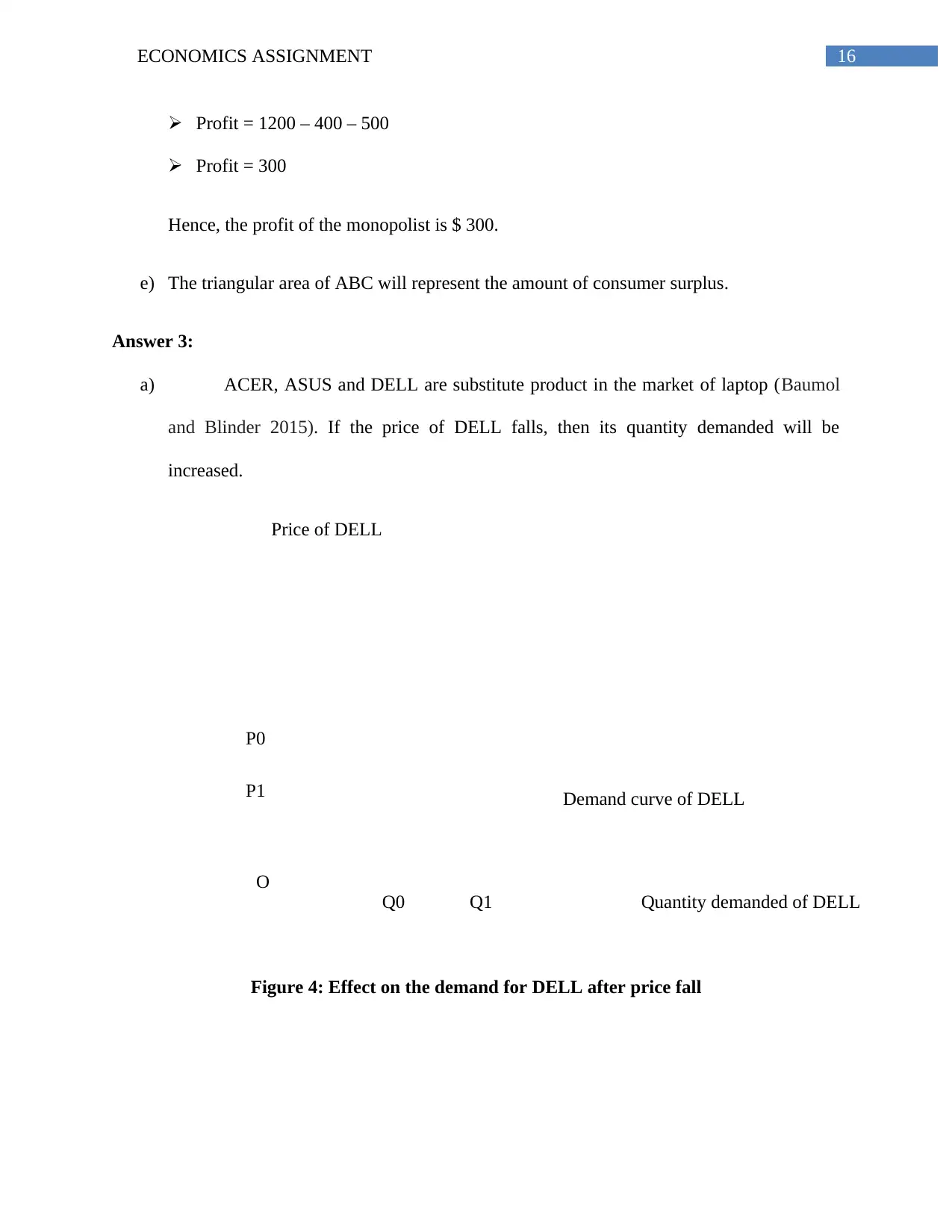
16ECONOMICS ASSIGNMENT
Price of DELL
Quantity demanded of DELL
O
Demand curve of DELL
P0
P1
Q0 Q1
Profit = 1200 – 400 – 500
Profit = 300
Hence, the profit of the monopolist is $ 300.
e) The triangular area of ABC will represent the amount of consumer surplus.
Answer 3:
a) ACER, ASUS and DELL are substitute product in the market of laptop (Baumol
and Blinder 2015). If the price of DELL falls, then its quantity demanded will be
increased.
Figure 4: Effect on the demand for DELL after price fall
Price of DELL
Quantity demanded of DELL
O
Demand curve of DELL
P0
P1
Q0 Q1
Profit = 1200 – 400 – 500
Profit = 300
Hence, the profit of the monopolist is $ 300.
e) The triangular area of ABC will represent the amount of consumer surplus.
Answer 3:
a) ACER, ASUS and DELL are substitute product in the market of laptop (Baumol
and Blinder 2015). If the price of DELL falls, then its quantity demanded will be
increased.
Figure 4: Effect on the demand for DELL after price fall
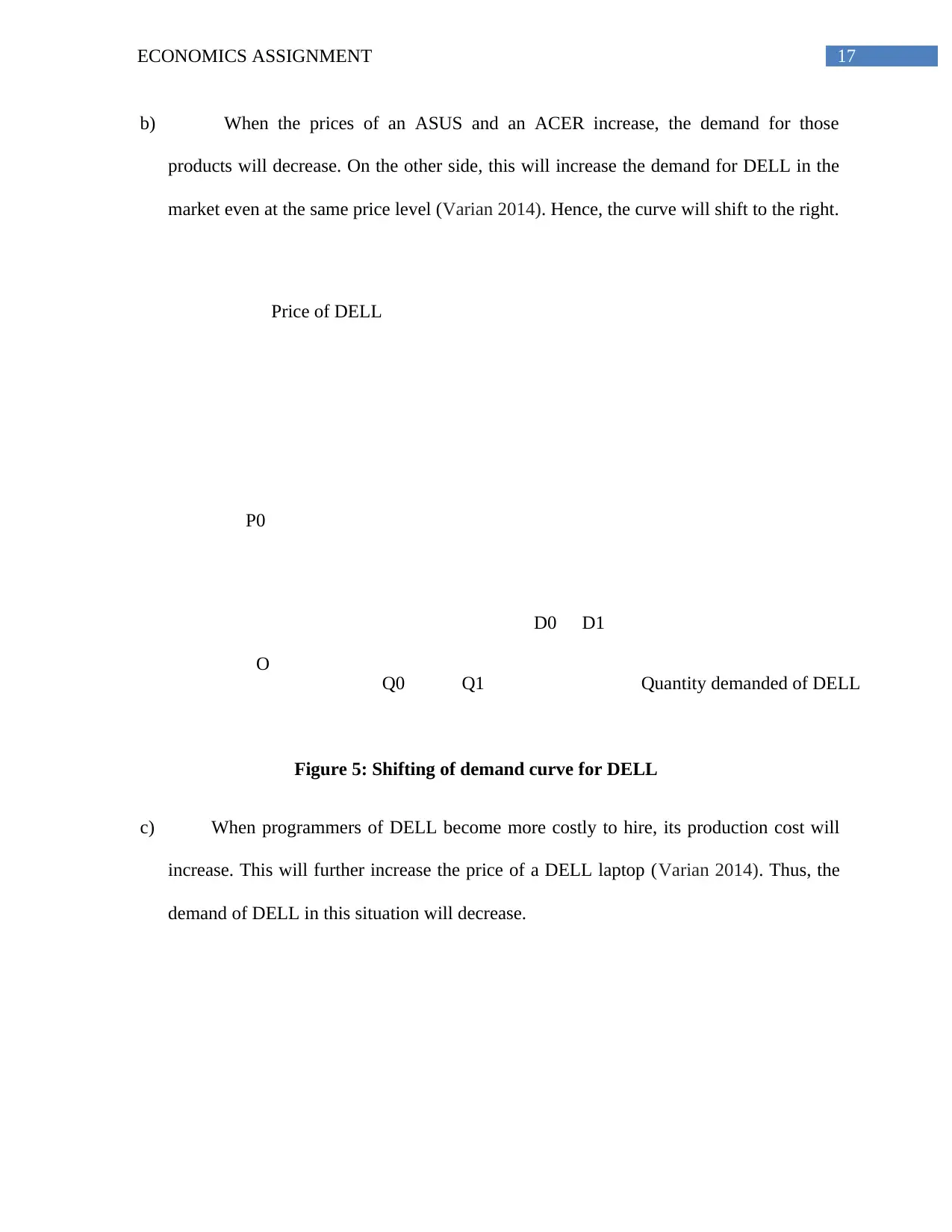
17ECONOMICS ASSIGNMENT
Price of DELL
Quantity demanded of DELL
O
P0
Q0 Q1
D0 D1
b) When the prices of an ASUS and an ACER increase, the demand for those
products will decrease. On the other side, this will increase the demand for DELL in the
market even at the same price level (Varian 2014). Hence, the curve will shift to the right.
Figure 5: Shifting of demand curve for DELL
c) When programmers of DELL become more costly to hire, its production cost will
increase. This will further increase the price of a DELL laptop (Varian 2014). Thus, the
demand of DELL in this situation will decrease.
Price of DELL
Quantity demanded of DELL
O
P0
Q0 Q1
D0 D1
b) When the prices of an ASUS and an ACER increase, the demand for those
products will decrease. On the other side, this will increase the demand for DELL in the
market even at the same price level (Varian 2014). Hence, the curve will shift to the right.
Figure 5: Shifting of demand curve for DELL
c) When programmers of DELL become more costly to hire, its production cost will
increase. This will further increase the price of a DELL laptop (Varian 2014). Thus, the
demand of DELL in this situation will decrease.
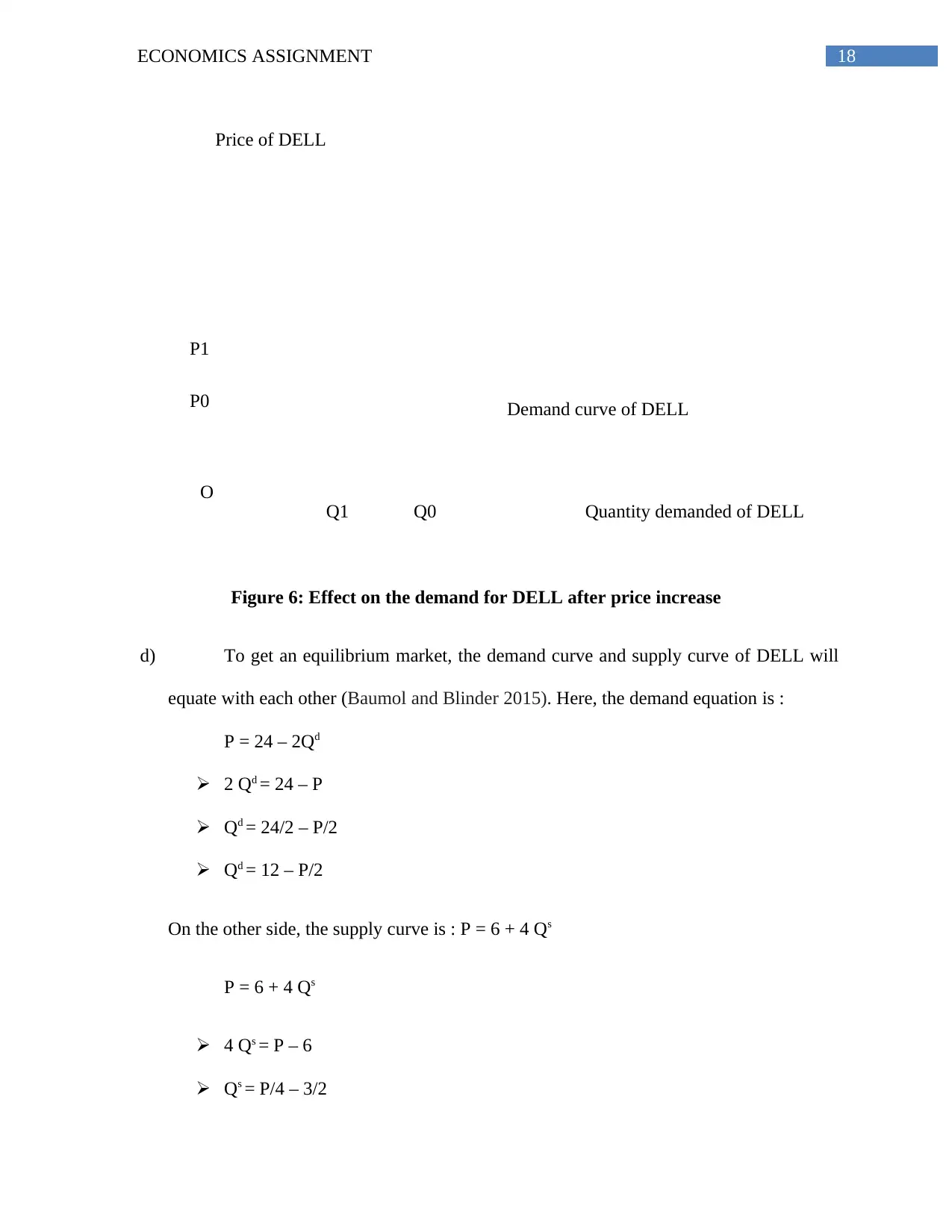
18ECONOMICS ASSIGNMENT
Price of DELL
Quantity demanded of DELL
O
Demand curve of DELL
P1
P0
Q1 Q0
Figure 6: Effect on the demand for DELL after price increase
d) To get an equilibrium market, the demand curve and supply curve of DELL will
equate with each other (Baumol and Blinder 2015). Here, the demand equation is :
P = 24 – 2Qd
2 Qd = 24 – P
Qd = 24/2 – P/2
Qd = 12 – P/2
On the other side, the supply curve is : P = 6 + 4 Qs
P = 6 + 4 Qs
4 Qs = P – 6
Qs = P/4 – 3/2
Price of DELL
Quantity demanded of DELL
O
Demand curve of DELL
P1
P0
Q1 Q0
Figure 6: Effect on the demand for DELL after price increase
d) To get an equilibrium market, the demand curve and supply curve of DELL will
equate with each other (Baumol and Blinder 2015). Here, the demand equation is :
P = 24 – 2Qd
2 Qd = 24 – P
Qd = 24/2 – P/2
Qd = 12 – P/2
On the other side, the supply curve is : P = 6 + 4 Qs
P = 6 + 4 Qs
4 Qs = P – 6
Qs = P/4 – 3/2
Paraphrase This Document
Need a fresh take? Get an instant paraphrase of this document with our AI Paraphraser
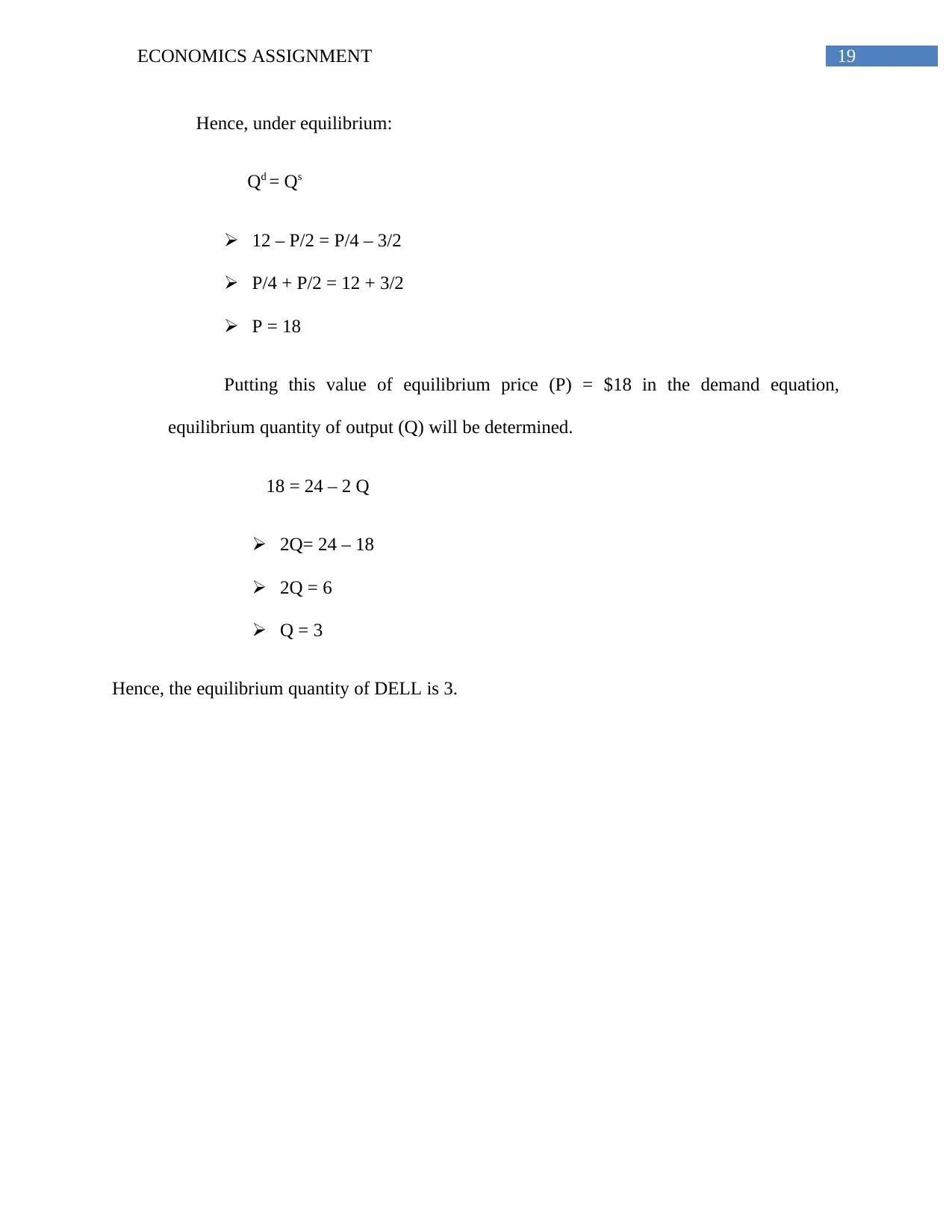
19ECONOMICS ASSIGNMENT
Hence, under equilibrium:
Qd = Qs
12 – P/2 = P/4 – 3/2
P/4 + P/2 = 12 + 3/2
P = 18
Putting this value of equilibrium price (P) = $18 in the demand equation,
equilibrium quantity of output (Q) will be determined.
18 = 24 – 2 Q
2Q= 24 – 18
2Q = 6
Q = 3
Hence, the equilibrium quantity of DELL is 3.
Hence, under equilibrium:
Qd = Qs
12 – P/2 = P/4 – 3/2
P/4 + P/2 = 12 + 3/2
P = 18
Putting this value of equilibrium price (P) = $18 in the demand equation,
equilibrium quantity of output (Q) will be determined.
18 = 24 – 2 Q
2Q= 24 – 18
2Q = 6
Q = 3
Hence, the equilibrium quantity of DELL is 3.
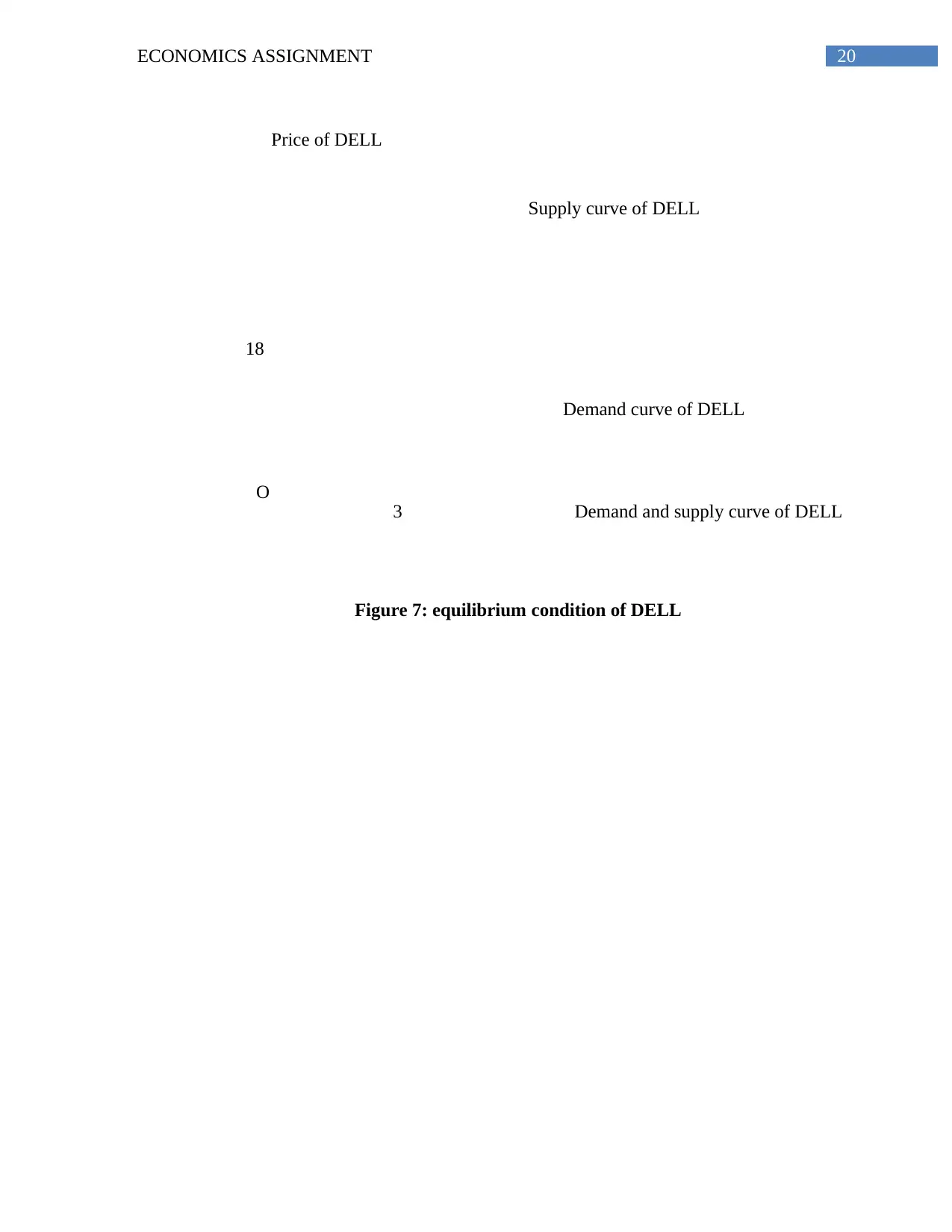
20ECONOMICS ASSIGNMENT
Price of DELL
Demand and supply curve of DELL
O
Demand curve of DELL
18
3
Supply curve of DELL
Figure 7: equilibrium condition of DELL
Price of DELL
Demand and supply curve of DELL
O
Demand curve of DELL
18
3
Supply curve of DELL
Figure 7: equilibrium condition of DELL
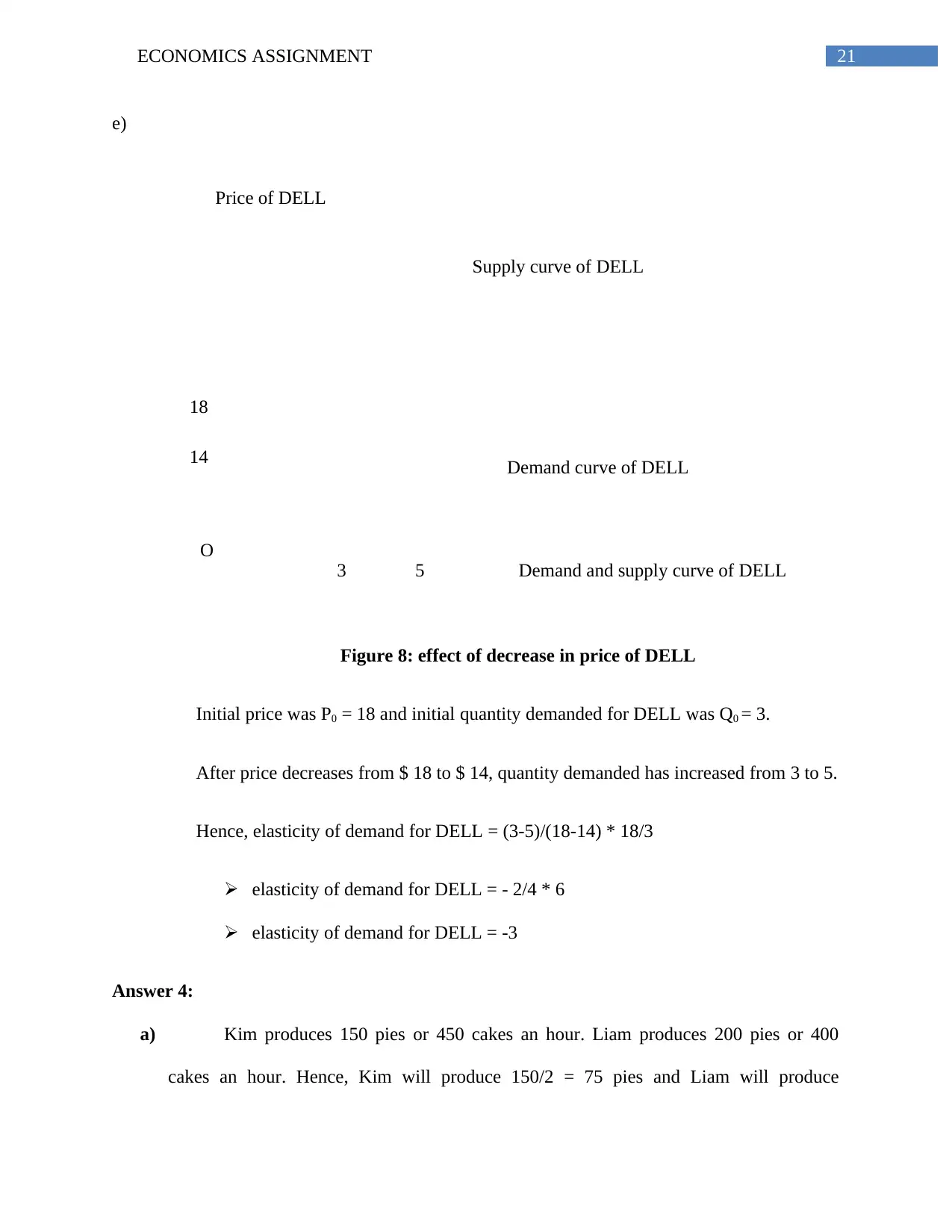
21ECONOMICS ASSIGNMENT
Price of DELL
Demand and supply curve of DELL
O
Demand curve of DELL
18
3
Supply curve of DELL
14
5
e)
Figure 8: effect of decrease in price of DELL
Initial price was P0 = 18 and initial quantity demanded for DELL was Q0 = 3.
After price decreases from $ 18 to $ 14, quantity demanded has increased from 3 to 5.
Hence, elasticity of demand for DELL = (3-5)/(18-14) * 18/3
elasticity of demand for DELL = - 2/4 * 6
elasticity of demand for DELL = -3
Answer 4:
a) Kim produces 150 pies or 450 cakes an hour. Liam produces 200 pies or 400
cakes an hour. Hence, Kim will produce 150/2 = 75 pies and Liam will produce
Price of DELL
Demand and supply curve of DELL
O
Demand curve of DELL
18
3
Supply curve of DELL
14
5
e)
Figure 8: effect of decrease in price of DELL
Initial price was P0 = 18 and initial quantity demanded for DELL was Q0 = 3.
After price decreases from $ 18 to $ 14, quantity demanded has increased from 3 to 5.
Hence, elasticity of demand for DELL = (3-5)/(18-14) * 18/3
elasticity of demand for DELL = - 2/4 * 6
elasticity of demand for DELL = -3
Answer 4:
a) Kim produces 150 pies or 450 cakes an hour. Liam produces 200 pies or 400
cakes an hour. Hence, Kim will produce 150/2 = 75 pies and Liam will produce
Secure Best Marks with AI Grader
Need help grading? Try our AI Grader for instant feedback on your assignments.
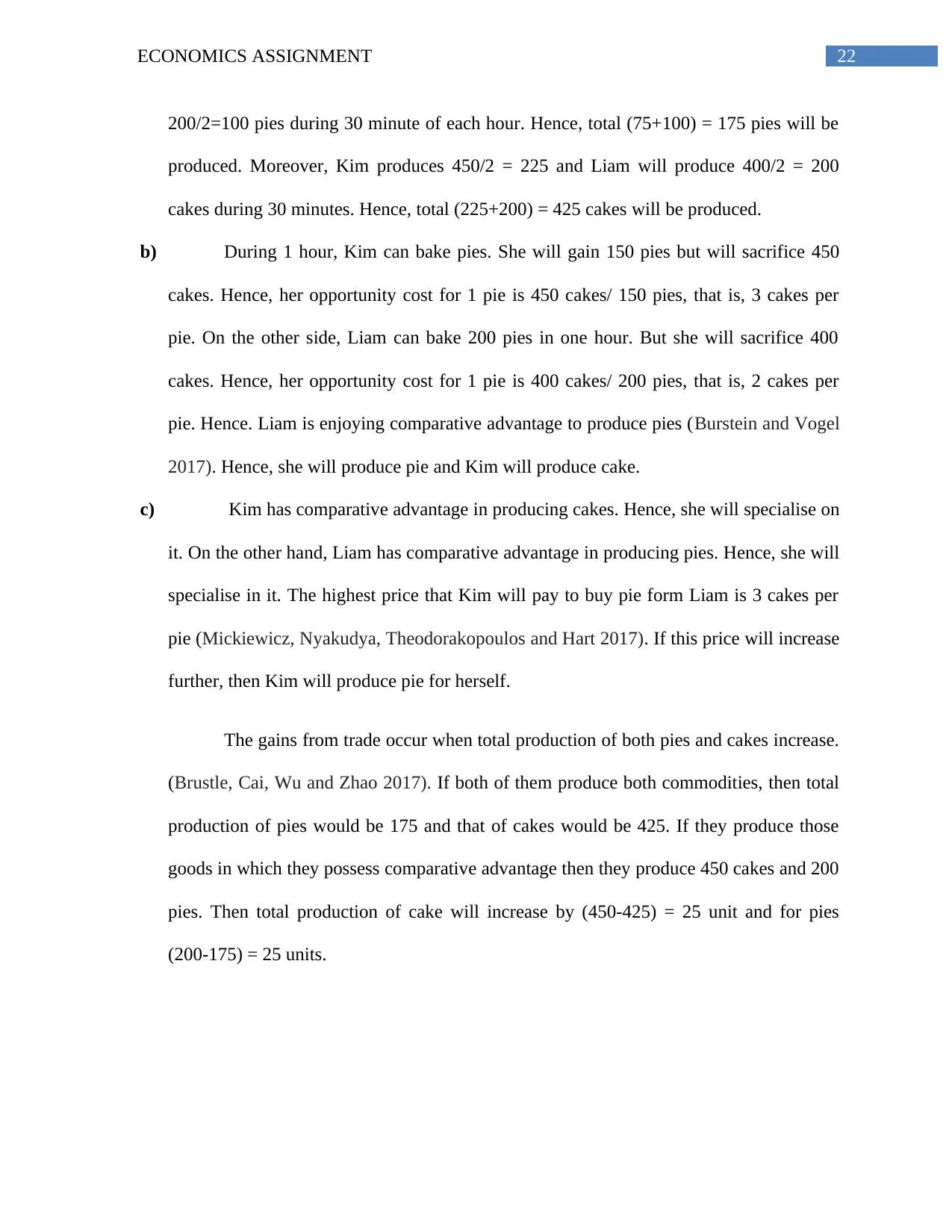
22ECONOMICS ASSIGNMENT
200/2=100 pies during 30 minute of each hour. Hence, total (75+100) = 175 pies will be
produced. Moreover, Kim produces 450/2 = 225 and Liam will produce 400/2 = 200
cakes during 30 minutes. Hence, total (225+200) = 425 cakes will be produced.
b) During 1 hour, Kim can bake pies. She will gain 150 pies but will sacrifice 450
cakes. Hence, her opportunity cost for 1 pie is 450 cakes/ 150 pies, that is, 3 cakes per
pie. On the other side, Liam can bake 200 pies in one hour. But she will sacrifice 400
cakes. Hence, her opportunity cost for 1 pie is 400 cakes/ 200 pies, that is, 2 cakes per
pie. Hence. Liam is enjoying comparative advantage to produce pies (Burstein and Vogel
2017). Hence, she will produce pie and Kim will produce cake.
c) Kim has comparative advantage in producing cakes. Hence, she will specialise on
it. On the other hand, Liam has comparative advantage in producing pies. Hence, she will
specialise in it. The highest price that Kim will pay to buy pie form Liam is 3 cakes per
pie (Mickiewicz, Nyakudya, Theodorakopoulos and Hart 2017). If this price will increase
further, then Kim will produce pie for herself.
The gains from trade occur when total production of both pies and cakes increase.
(Brustle, Cai, Wu and Zhao 2017). If both of them produce both commodities, then total
production of pies would be 175 and that of cakes would be 425. If they produce those
goods in which they possess comparative advantage then they produce 450 cakes and 200
pies. Then total production of cake will increase by (450-425) = 25 unit and for pies
(200-175) = 25 units.
200/2=100 pies during 30 minute of each hour. Hence, total (75+100) = 175 pies will be
produced. Moreover, Kim produces 450/2 = 225 and Liam will produce 400/2 = 200
cakes during 30 minutes. Hence, total (225+200) = 425 cakes will be produced.
b) During 1 hour, Kim can bake pies. She will gain 150 pies but will sacrifice 450
cakes. Hence, her opportunity cost for 1 pie is 450 cakes/ 150 pies, that is, 3 cakes per
pie. On the other side, Liam can bake 200 pies in one hour. But she will sacrifice 400
cakes. Hence, her opportunity cost for 1 pie is 400 cakes/ 200 pies, that is, 2 cakes per
pie. Hence. Liam is enjoying comparative advantage to produce pies (Burstein and Vogel
2017). Hence, she will produce pie and Kim will produce cake.
c) Kim has comparative advantage in producing cakes. Hence, she will specialise on
it. On the other hand, Liam has comparative advantage in producing pies. Hence, she will
specialise in it. The highest price that Kim will pay to buy pie form Liam is 3 cakes per
pie (Mickiewicz, Nyakudya, Theodorakopoulos and Hart 2017). If this price will increase
further, then Kim will produce pie for herself.
The gains from trade occur when total production of both pies and cakes increase.
(Brustle, Cai, Wu and Zhao 2017). If both of them produce both commodities, then total
production of pies would be 175 and that of cakes would be 425. If they produce those
goods in which they possess comparative advantage then they produce 450 cakes and 200
pies. Then total production of cake will increase by (450-425) = 25 unit and for pies
(200-175) = 25 units.
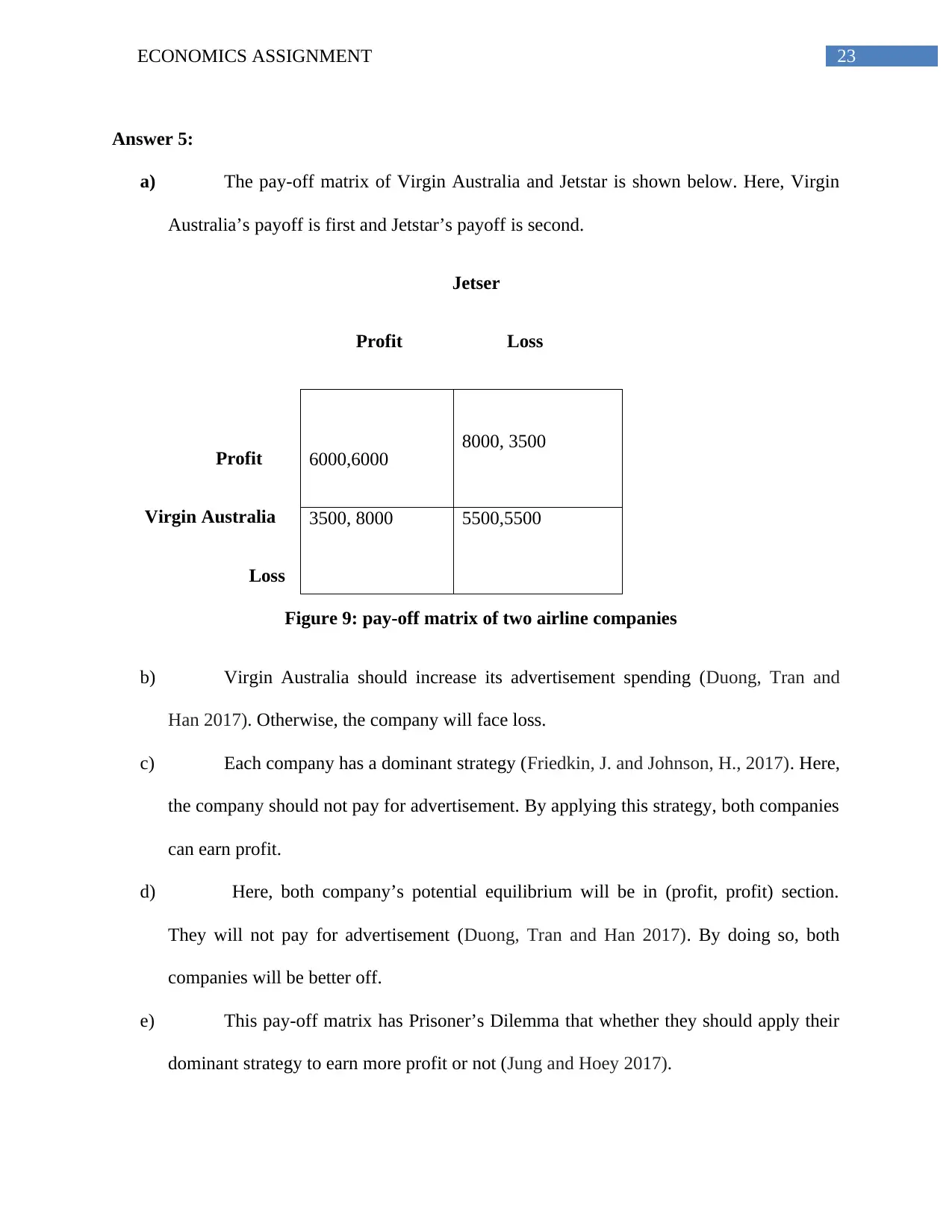
23ECONOMICS ASSIGNMENT
Answer 5:
a) The pay-off matrix of Virgin Australia and Jetstar is shown below. Here, Virgin
Australia’s payoff is first and Jetstar’s payoff is second.
Jetser
Profit Loss
Profit
Virgin Australia
Loss
Figure 9: pay-off matrix of two airline companies
b) Virgin Australia should increase its advertisement spending (Duong, Tran and
Han 2017). Otherwise, the company will face loss.
c) Each company has a dominant strategy (Friedkin, J. and Johnson, H., 2017). Here,
the company should not pay for advertisement. By applying this strategy, both companies
can earn profit.
d) Here, both company’s potential equilibrium will be in (profit, profit) section.
They will not pay for advertisement (Duong, Tran and Han 2017). By doing so, both
companies will be better off.
e) This pay-off matrix has Prisoner’s Dilemma that whether they should apply their
dominant strategy to earn more profit or not (Jung and Hoey 2017).
6000,6000 8000, 3500
3500, 8000 5500,5500
Answer 5:
a) The pay-off matrix of Virgin Australia and Jetstar is shown below. Here, Virgin
Australia’s payoff is first and Jetstar’s payoff is second.
Jetser
Profit Loss
Profit
Virgin Australia
Loss
Figure 9: pay-off matrix of two airline companies
b) Virgin Australia should increase its advertisement spending (Duong, Tran and
Han 2017). Otherwise, the company will face loss.
c) Each company has a dominant strategy (Friedkin, J. and Johnson, H., 2017). Here,
the company should not pay for advertisement. By applying this strategy, both companies
can earn profit.
d) Here, both company’s potential equilibrium will be in (profit, profit) section.
They will not pay for advertisement (Duong, Tran and Han 2017). By doing so, both
companies will be better off.
e) This pay-off matrix has Prisoner’s Dilemma that whether they should apply their
dominant strategy to earn more profit or not (Jung and Hoey 2017).
6000,6000 8000, 3500
3500, 8000 5500,5500

24ECONOMICS ASSIGNMENT
Paraphrase This Document
Need a fresh take? Get an instant paraphrase of this document with our AI Paraphraser
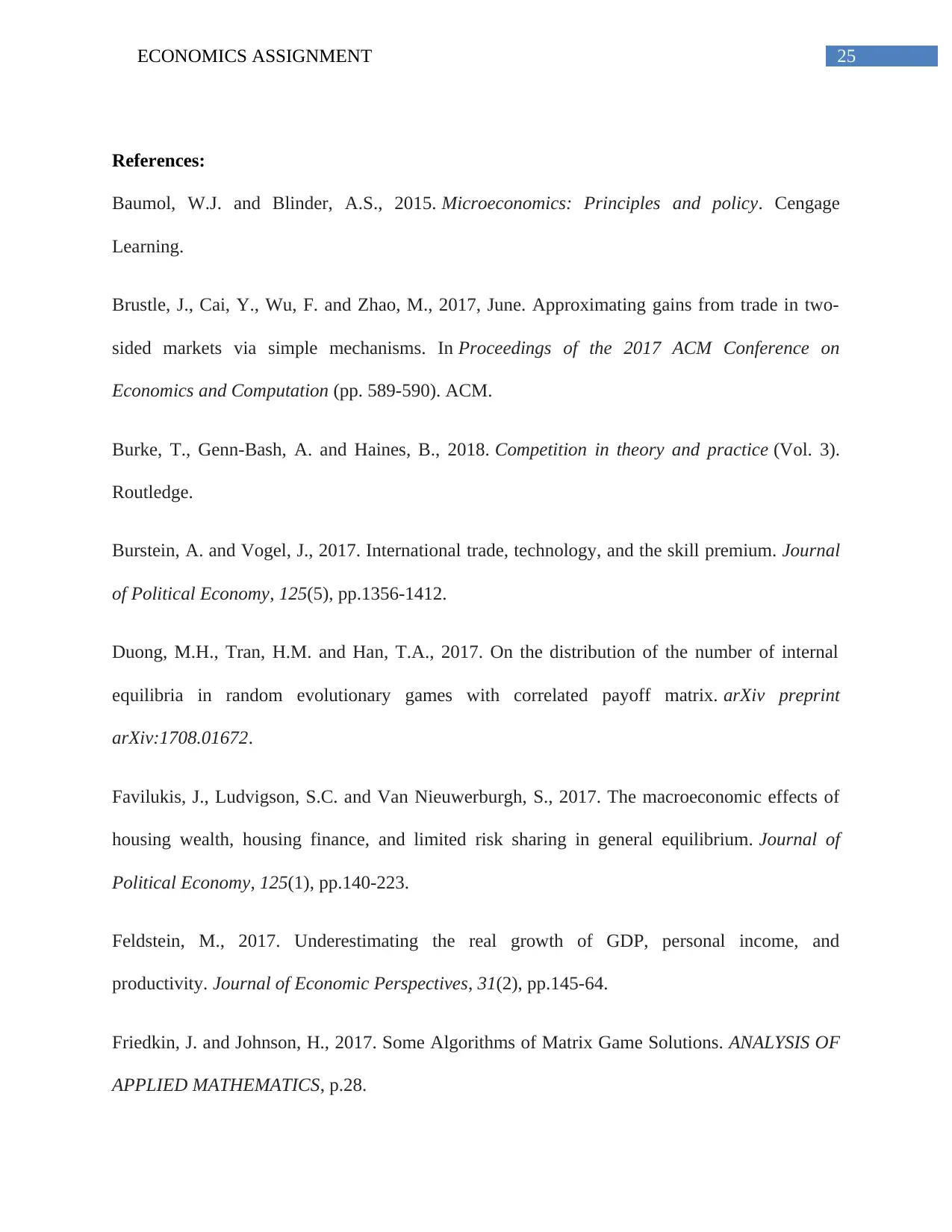
25ECONOMICS ASSIGNMENT
References:
Baumol, W.J. and Blinder, A.S., 2015. Microeconomics: Principles and policy. Cengage
Learning.
Brustle, J., Cai, Y., Wu, F. and Zhao, M., 2017, June. Approximating gains from trade in two-
sided markets via simple mechanisms. In Proceedings of the 2017 ACM Conference on
Economics and Computation (pp. 589-590). ACM.
Burke, T., Genn-Bash, A. and Haines, B., 2018. Competition in theory and practice (Vol. 3).
Routledge.
Burstein, A. and Vogel, J., 2017. International trade, technology, and the skill premium. Journal
of Political Economy, 125(5), pp.1356-1412.
Duong, M.H., Tran, H.M. and Han, T.A., 2017. On the distribution of the number of internal
equilibria in random evolutionary games with correlated payoff matrix. arXiv preprint
arXiv:1708.01672.
Favilukis, J., Ludvigson, S.C. and Van Nieuwerburgh, S., 2017. The macroeconomic effects of
housing wealth, housing finance, and limited risk sharing in general equilibrium. Journal of
Political Economy, 125(1), pp.140-223.
Feldstein, M., 2017. Underestimating the real growth of GDP, personal income, and
productivity. Journal of Economic Perspectives, 31(2), pp.145-64.
Friedkin, J. and Johnson, H., 2017. Some Algorithms of Matrix Game Solutions. ANALYSIS OF
APPLIED MATHEMATICS, p.28.
References:
Baumol, W.J. and Blinder, A.S., 2015. Microeconomics: Principles and policy. Cengage
Learning.
Brustle, J., Cai, Y., Wu, F. and Zhao, M., 2017, June. Approximating gains from trade in two-
sided markets via simple mechanisms. In Proceedings of the 2017 ACM Conference on
Economics and Computation (pp. 589-590). ACM.
Burke, T., Genn-Bash, A. and Haines, B., 2018. Competition in theory and practice (Vol. 3).
Routledge.
Burstein, A. and Vogel, J., 2017. International trade, technology, and the skill premium. Journal
of Political Economy, 125(5), pp.1356-1412.
Duong, M.H., Tran, H.M. and Han, T.A., 2017. On the distribution of the number of internal
equilibria in random evolutionary games with correlated payoff matrix. arXiv preprint
arXiv:1708.01672.
Favilukis, J., Ludvigson, S.C. and Van Nieuwerburgh, S., 2017. The macroeconomic effects of
housing wealth, housing finance, and limited risk sharing in general equilibrium. Journal of
Political Economy, 125(1), pp.140-223.
Feldstein, M., 2017. Underestimating the real growth of GDP, personal income, and
productivity. Journal of Economic Perspectives, 31(2), pp.145-64.
Friedkin, J. and Johnson, H., 2017. Some Algorithms of Matrix Game Solutions. ANALYSIS OF
APPLIED MATHEMATICS, p.28.
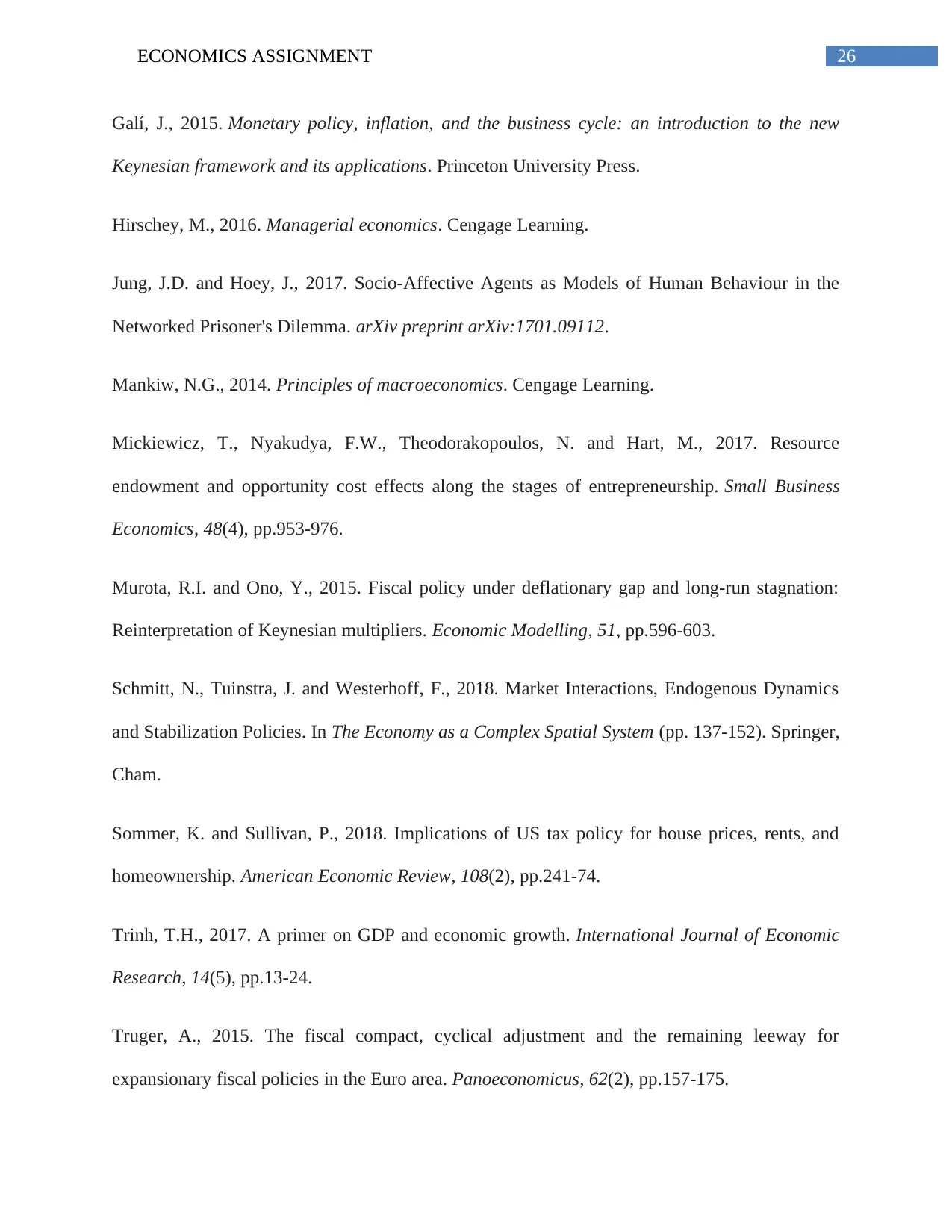
26ECONOMICS ASSIGNMENT
Galí, J., 2015. Monetary policy, inflation, and the business cycle: an introduction to the new
Keynesian framework and its applications. Princeton University Press.
Hirschey, M., 2016. Managerial economics. Cengage Learning.
Jung, J.D. and Hoey, J., 2017. Socio-Affective Agents as Models of Human Behaviour in the
Networked Prisoner's Dilemma. arXiv preprint arXiv:1701.09112.
Mankiw, N.G., 2014. Principles of macroeconomics. Cengage Learning.
Mickiewicz, T., Nyakudya, F.W., Theodorakopoulos, N. and Hart, M., 2017. Resource
endowment and opportunity cost effects along the stages of entrepreneurship. Small Business
Economics, 48(4), pp.953-976.
Murota, R.I. and Ono, Y., 2015. Fiscal policy under deflationary gap and long-run stagnation:
Reinterpretation of Keynesian multipliers. Economic Modelling, 51, pp.596-603.
Schmitt, N., Tuinstra, J. and Westerhoff, F., 2018. Market Interactions, Endogenous Dynamics
and Stabilization Policies. In The Economy as a Complex Spatial System (pp. 137-152). Springer,
Cham.
Sommer, K. and Sullivan, P., 2018. Implications of US tax policy for house prices, rents, and
homeownership. American Economic Review, 108(2), pp.241-74.
Trinh, T.H., 2017. A primer on GDP and economic growth. International Journal of Economic
Research, 14(5), pp.13-24.
Truger, A., 2015. The fiscal compact, cyclical adjustment and the remaining leeway for
expansionary fiscal policies in the Euro area. Panoeconomicus, 62(2), pp.157-175.
Galí, J., 2015. Monetary policy, inflation, and the business cycle: an introduction to the new
Keynesian framework and its applications. Princeton University Press.
Hirschey, M., 2016. Managerial economics. Cengage Learning.
Jung, J.D. and Hoey, J., 2017. Socio-Affective Agents as Models of Human Behaviour in the
Networked Prisoner's Dilemma. arXiv preprint arXiv:1701.09112.
Mankiw, N.G., 2014. Principles of macroeconomics. Cengage Learning.
Mickiewicz, T., Nyakudya, F.W., Theodorakopoulos, N. and Hart, M., 2017. Resource
endowment and opportunity cost effects along the stages of entrepreneurship. Small Business
Economics, 48(4), pp.953-976.
Murota, R.I. and Ono, Y., 2015. Fiscal policy under deflationary gap and long-run stagnation:
Reinterpretation of Keynesian multipliers. Economic Modelling, 51, pp.596-603.
Schmitt, N., Tuinstra, J. and Westerhoff, F., 2018. Market Interactions, Endogenous Dynamics
and Stabilization Policies. In The Economy as a Complex Spatial System (pp. 137-152). Springer,
Cham.
Sommer, K. and Sullivan, P., 2018. Implications of US tax policy for house prices, rents, and
homeownership. American Economic Review, 108(2), pp.241-74.
Trinh, T.H., 2017. A primer on GDP and economic growth. International Journal of Economic
Research, 14(5), pp.13-24.
Truger, A., 2015. The fiscal compact, cyclical adjustment and the remaining leeway for
expansionary fiscal policies in the Euro area. Panoeconomicus, 62(2), pp.157-175.

27ECONOMICS ASSIGNMENT
Tschopp, J., 2017. Wage formation: Towards isolating search and bargaining effects from the
marginal product. The Economic Journal, 127(603), pp.1693-1729.
Varian, H.R., 2014. Intermediate Microeconomics: A Modern Approach: Ninth International
Student Edition. WW Norton & Company.
Tschopp, J., 2017. Wage formation: Towards isolating search and bargaining effects from the
marginal product. The Economic Journal, 127(603), pp.1693-1729.
Varian, H.R., 2014. Intermediate Microeconomics: A Modern Approach: Ninth International
Student Edition. WW Norton & Company.
1 out of 28
Related Documents
Your All-in-One AI-Powered Toolkit for Academic Success.
+13062052269
info@desklib.com
Available 24*7 on WhatsApp / Email
![[object Object]](/_next/static/media/star-bottom.7253800d.svg)
Unlock your academic potential
© 2024 | Zucol Services PVT LTD | All rights reserved.




